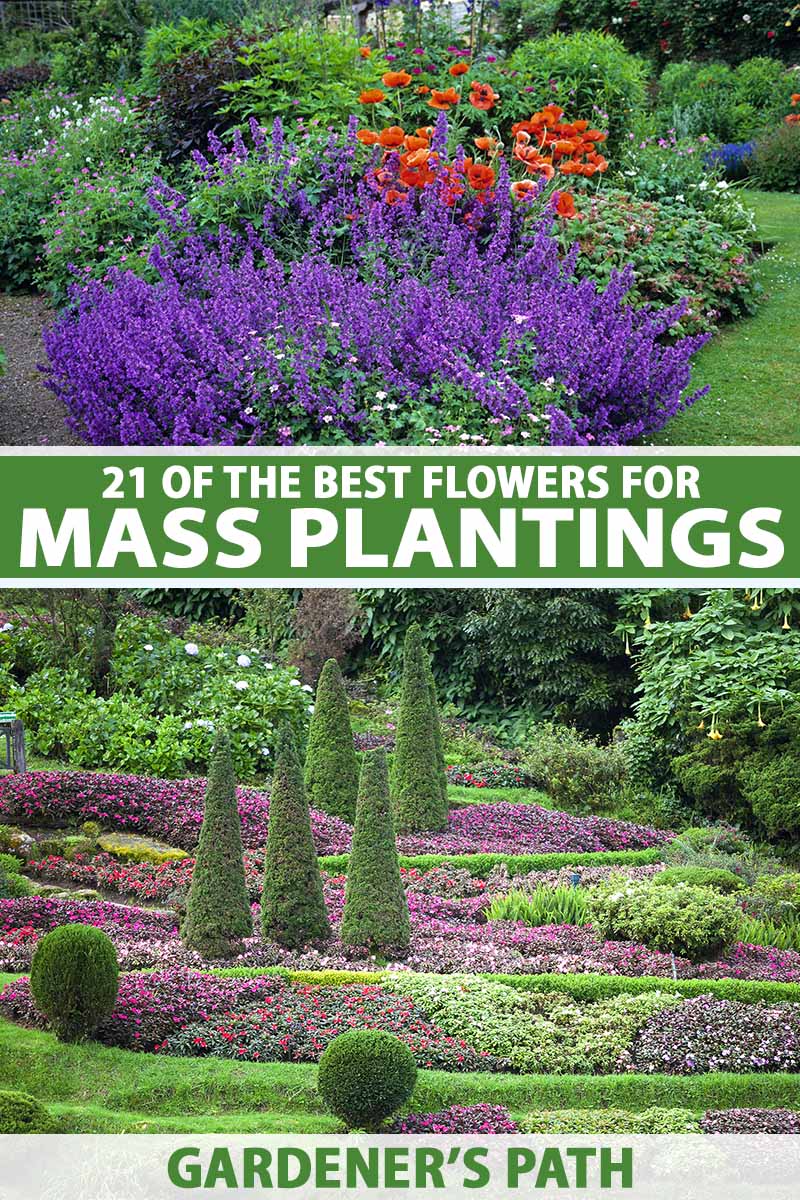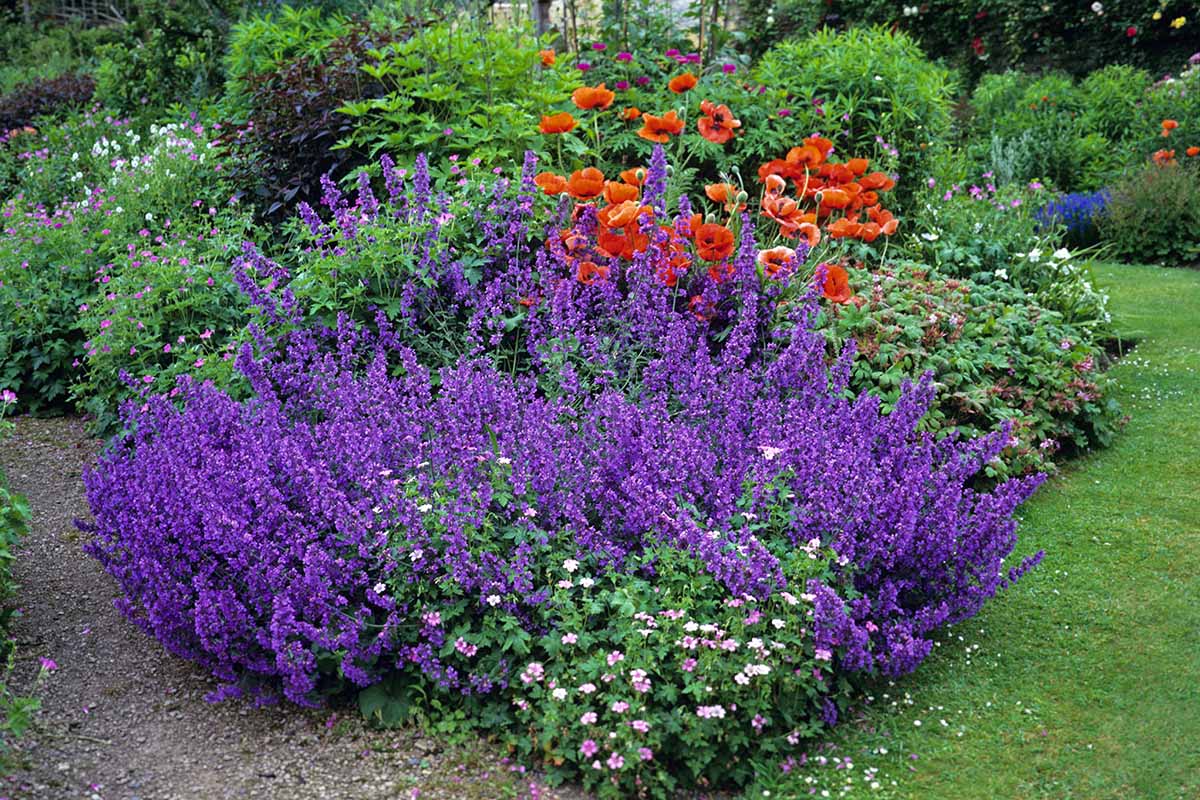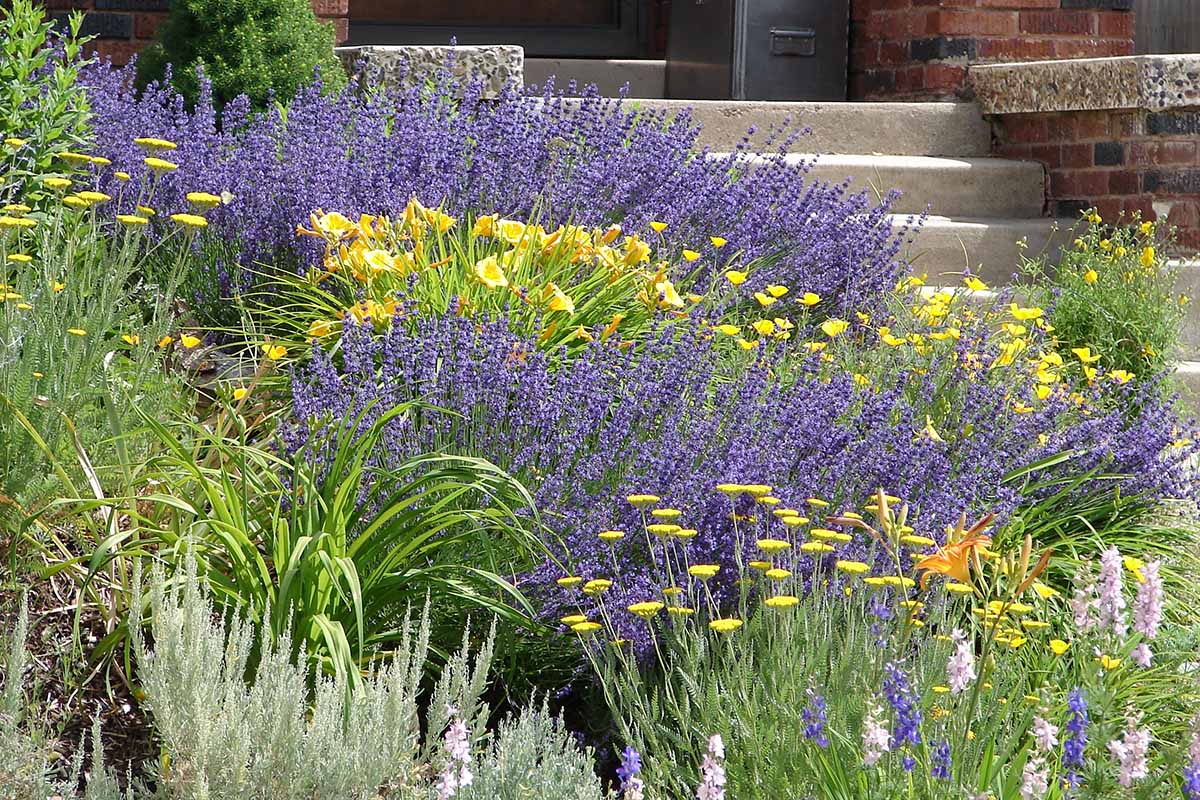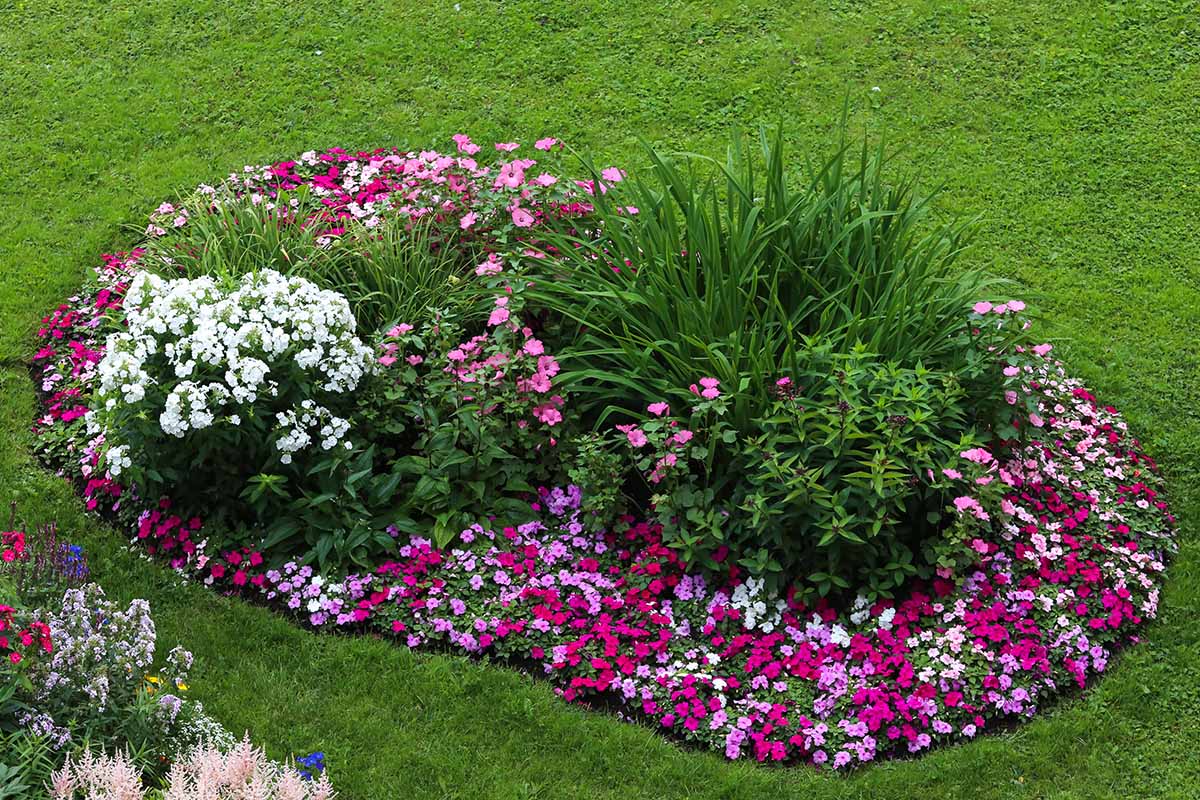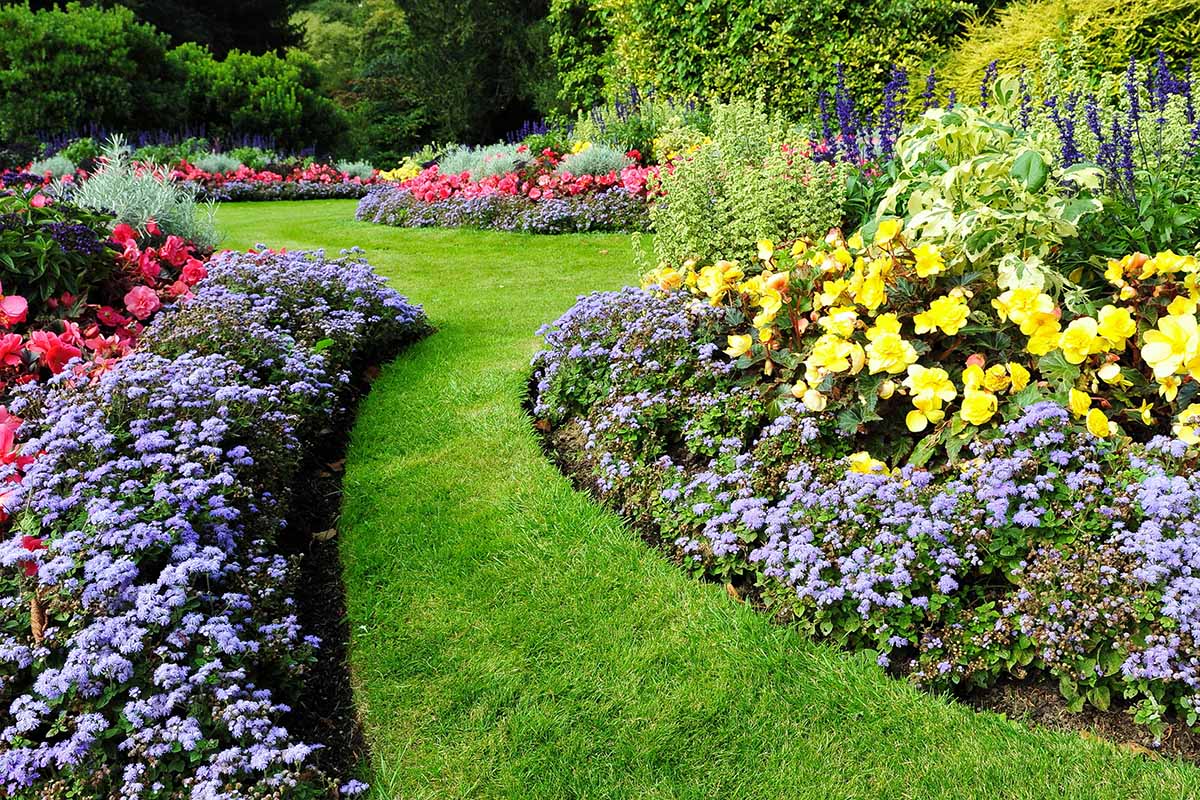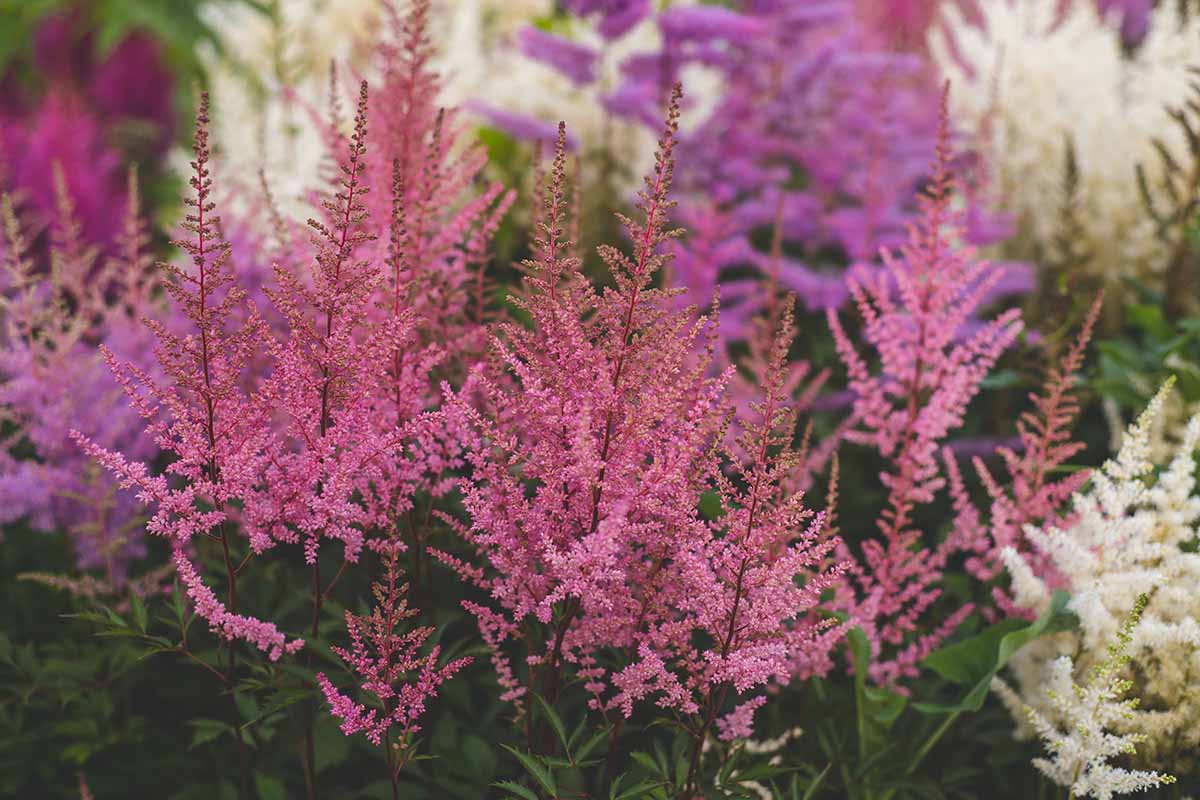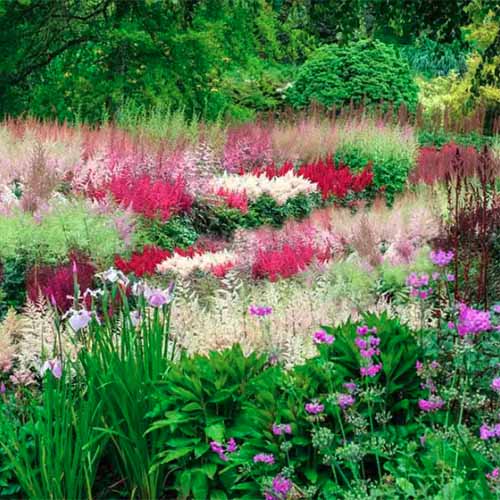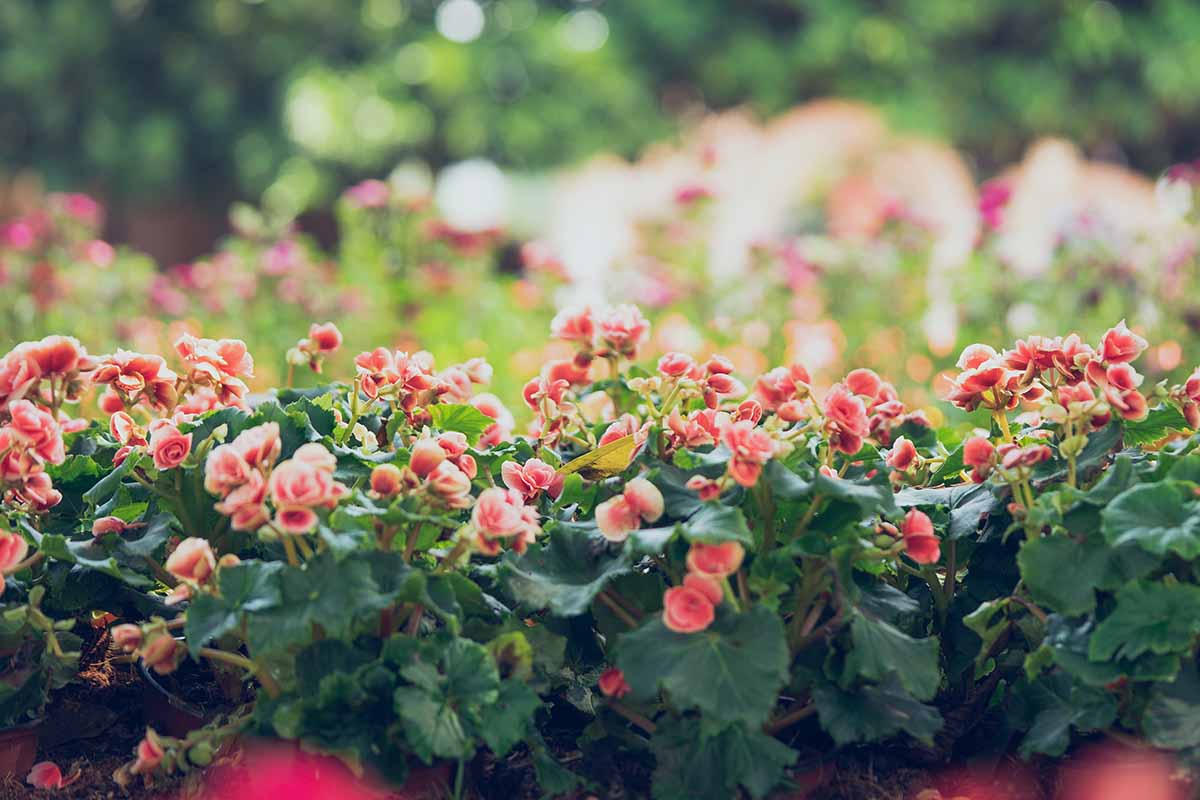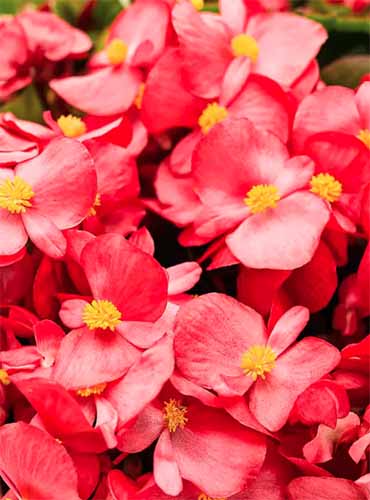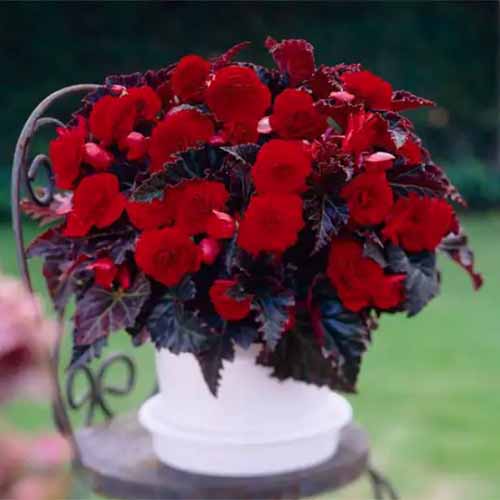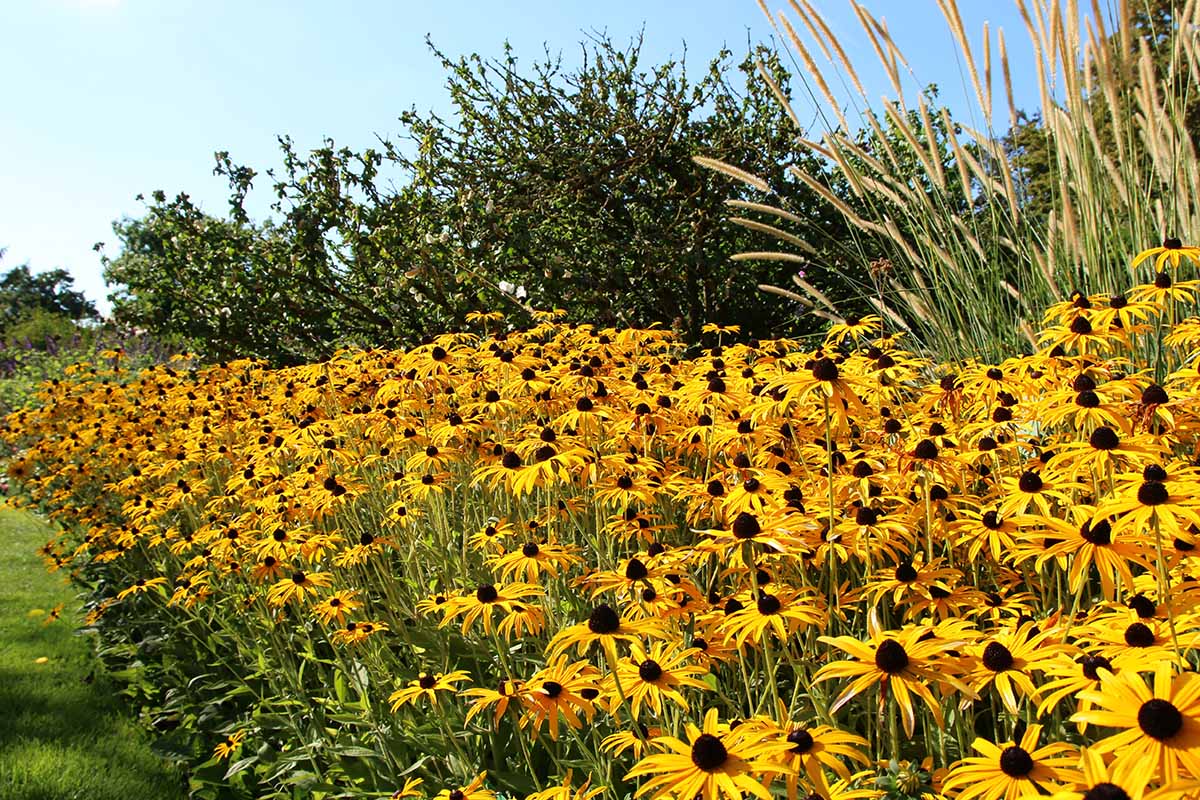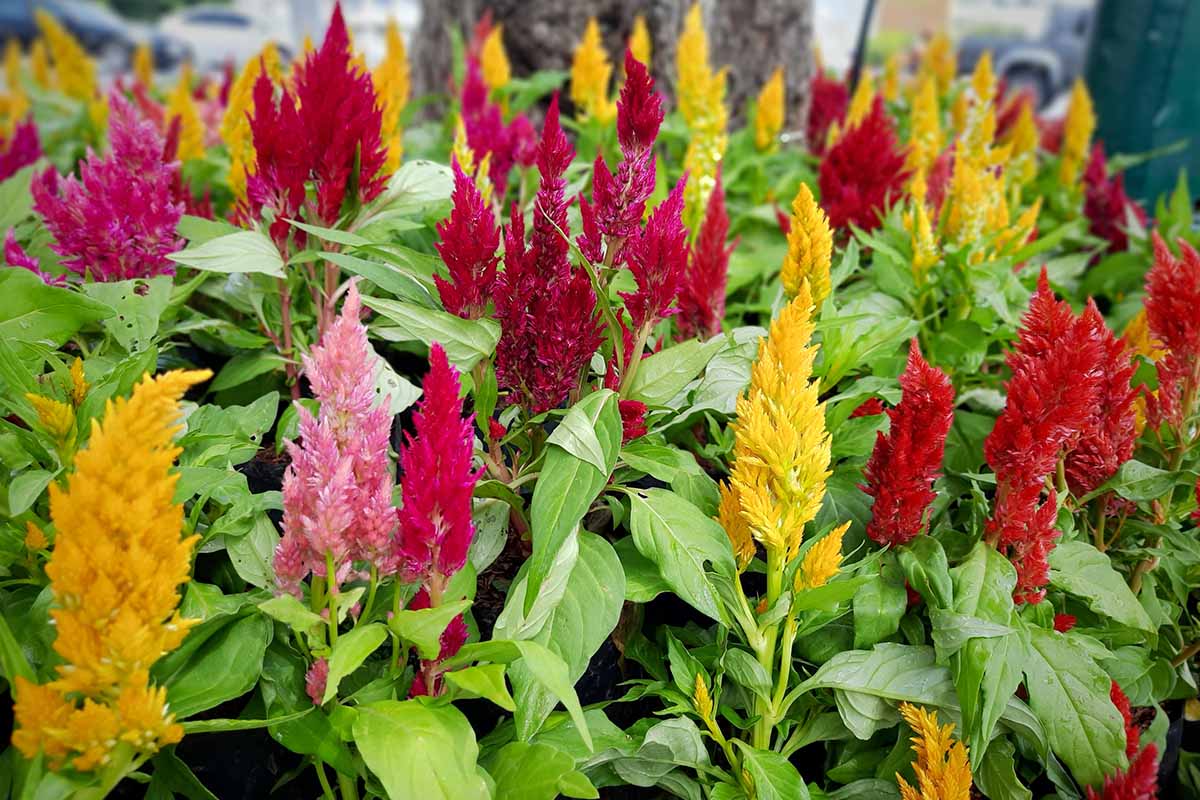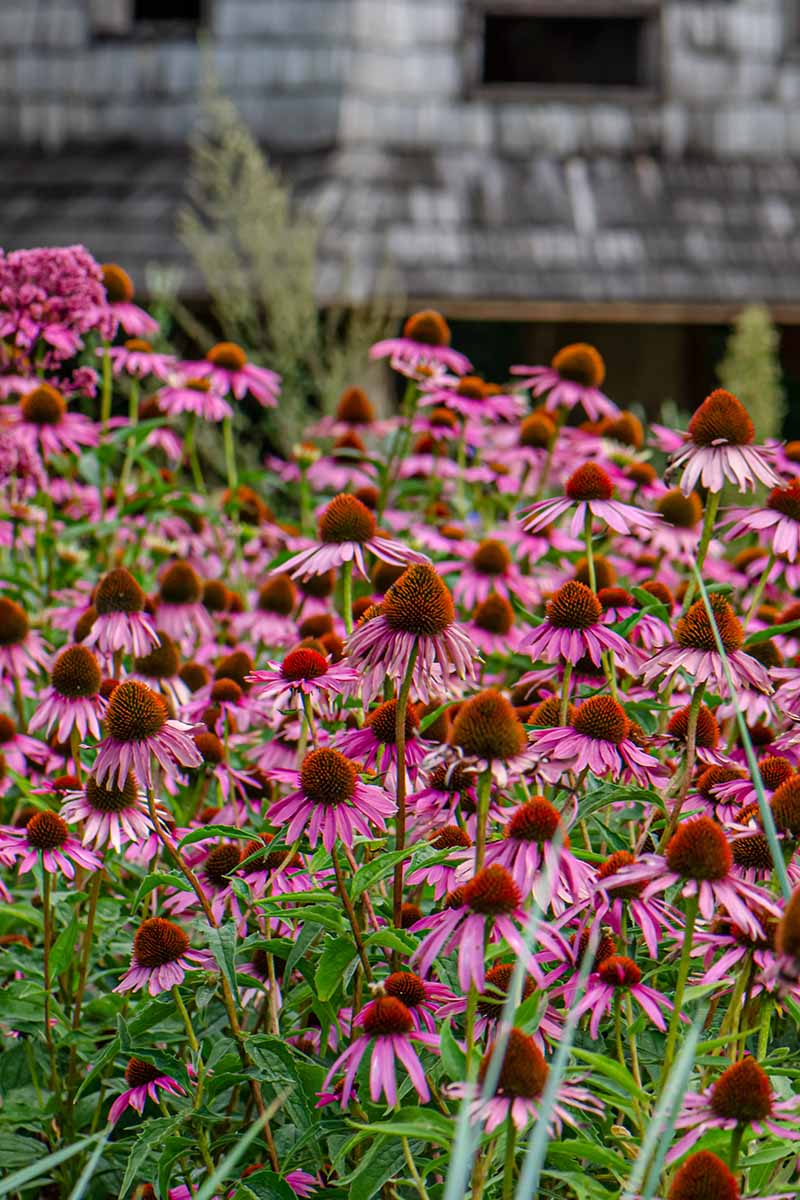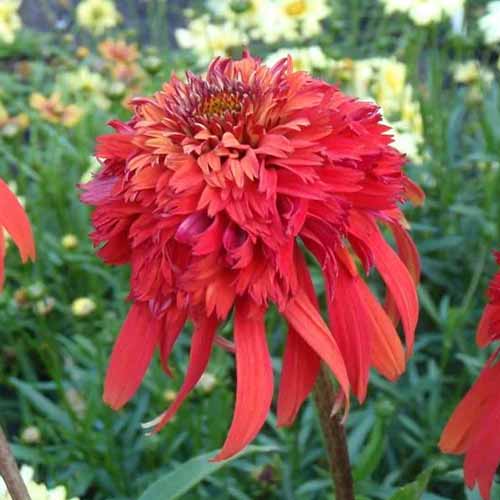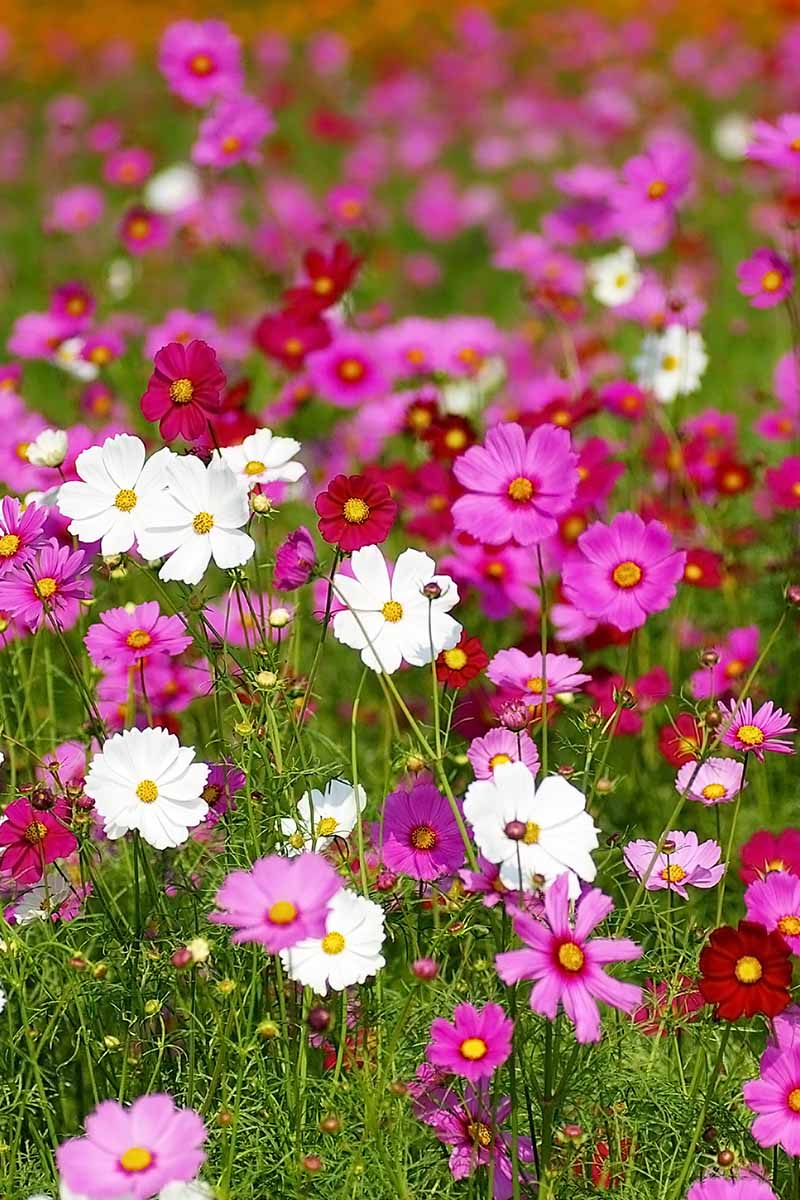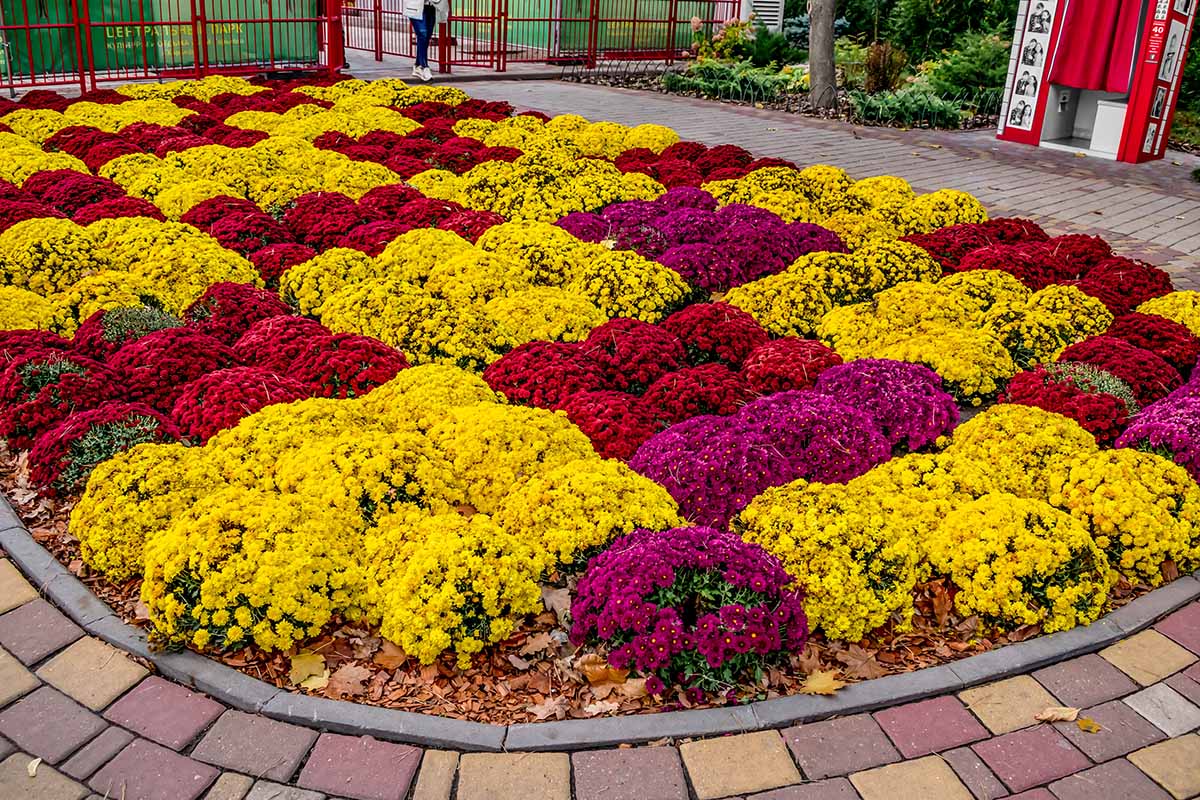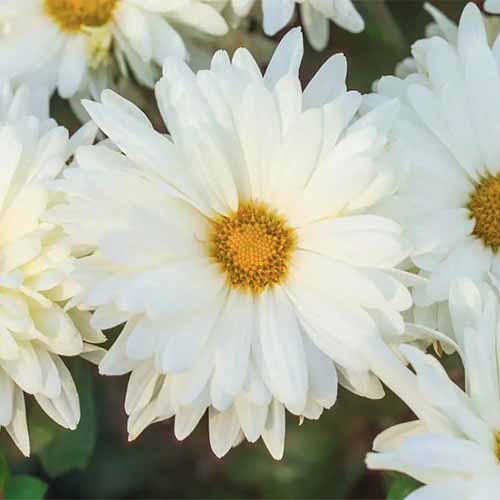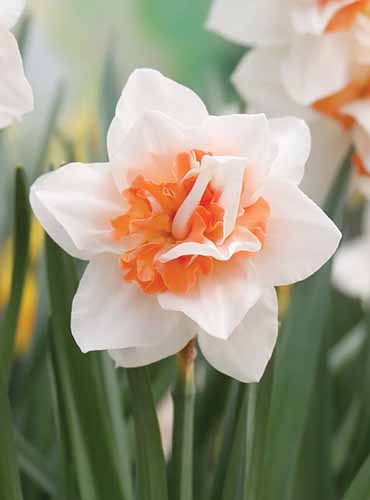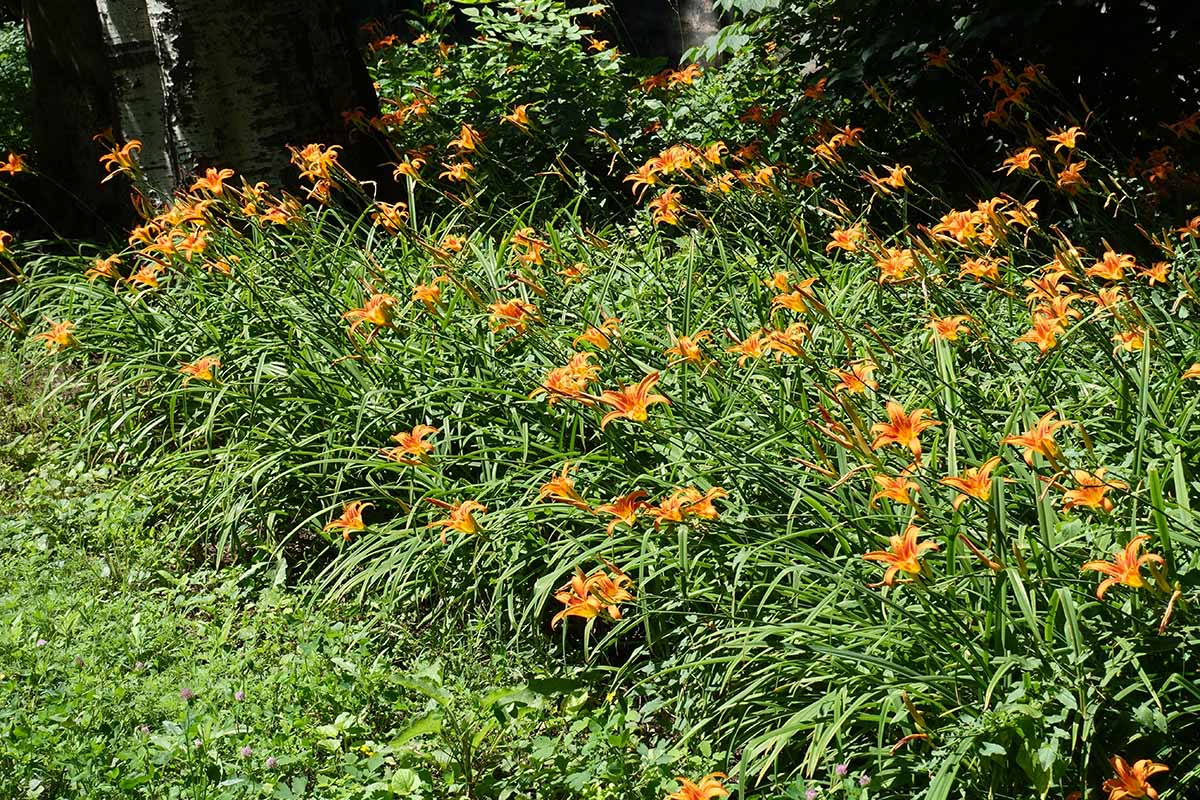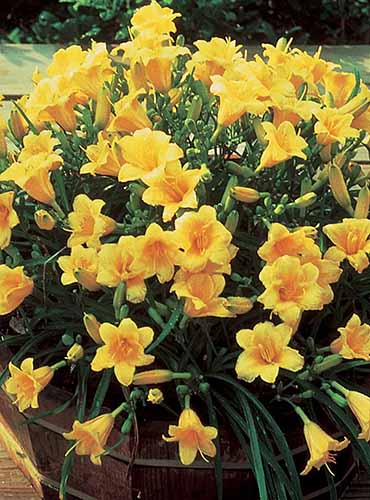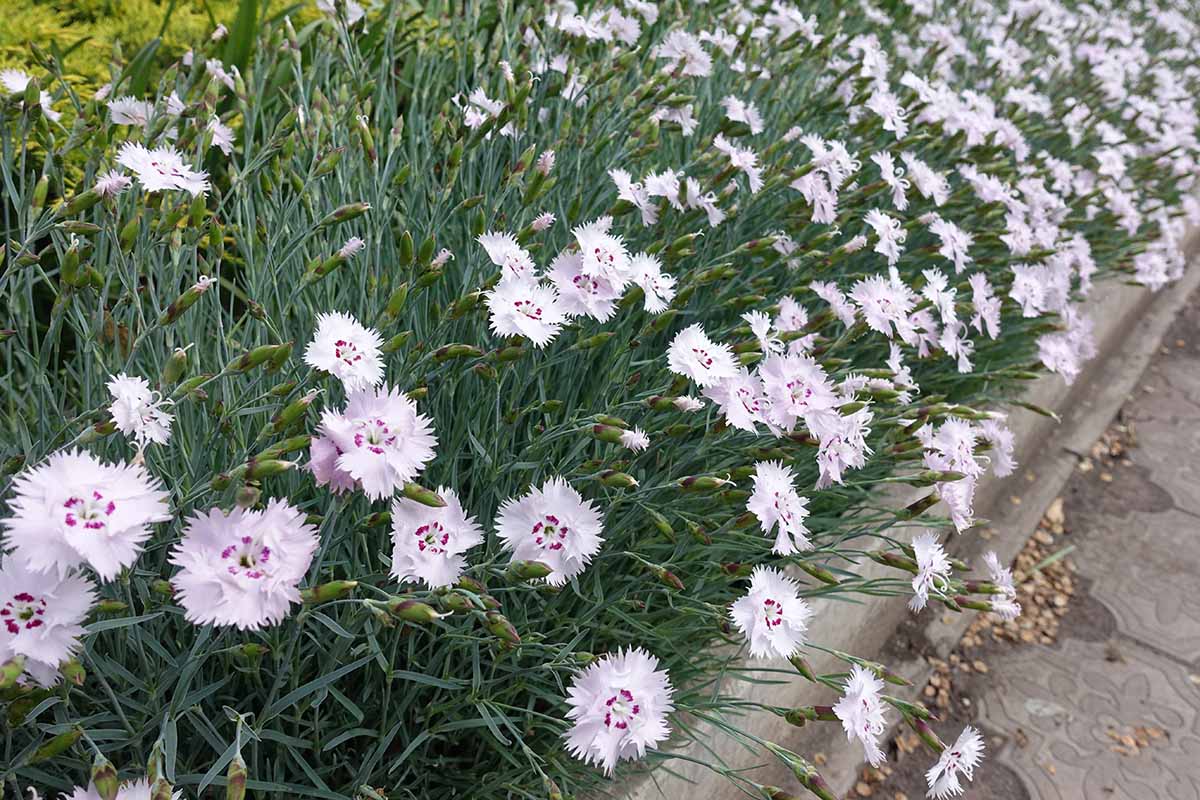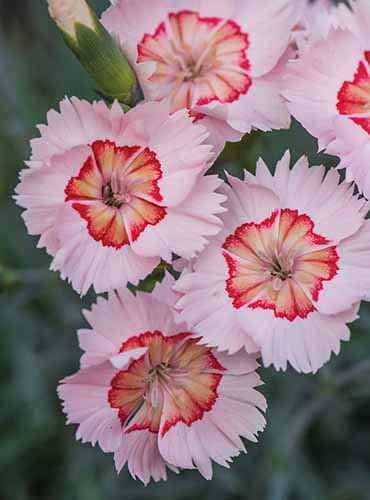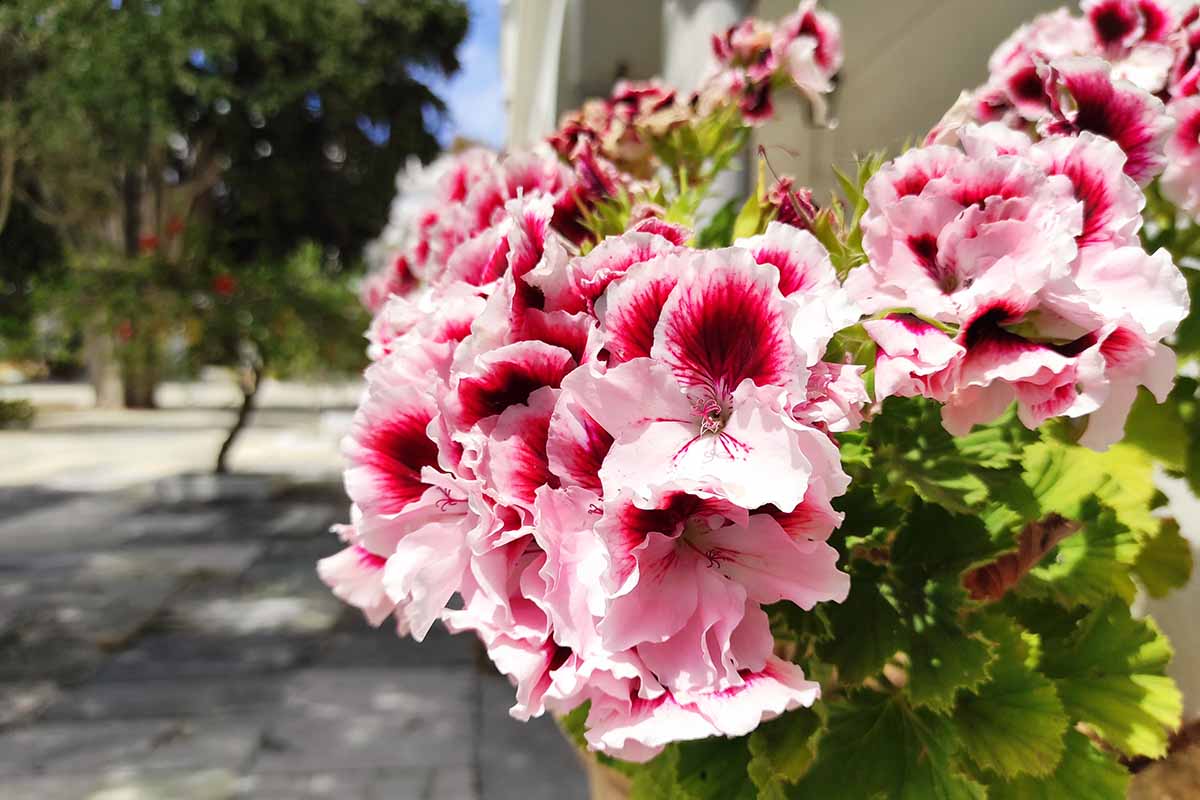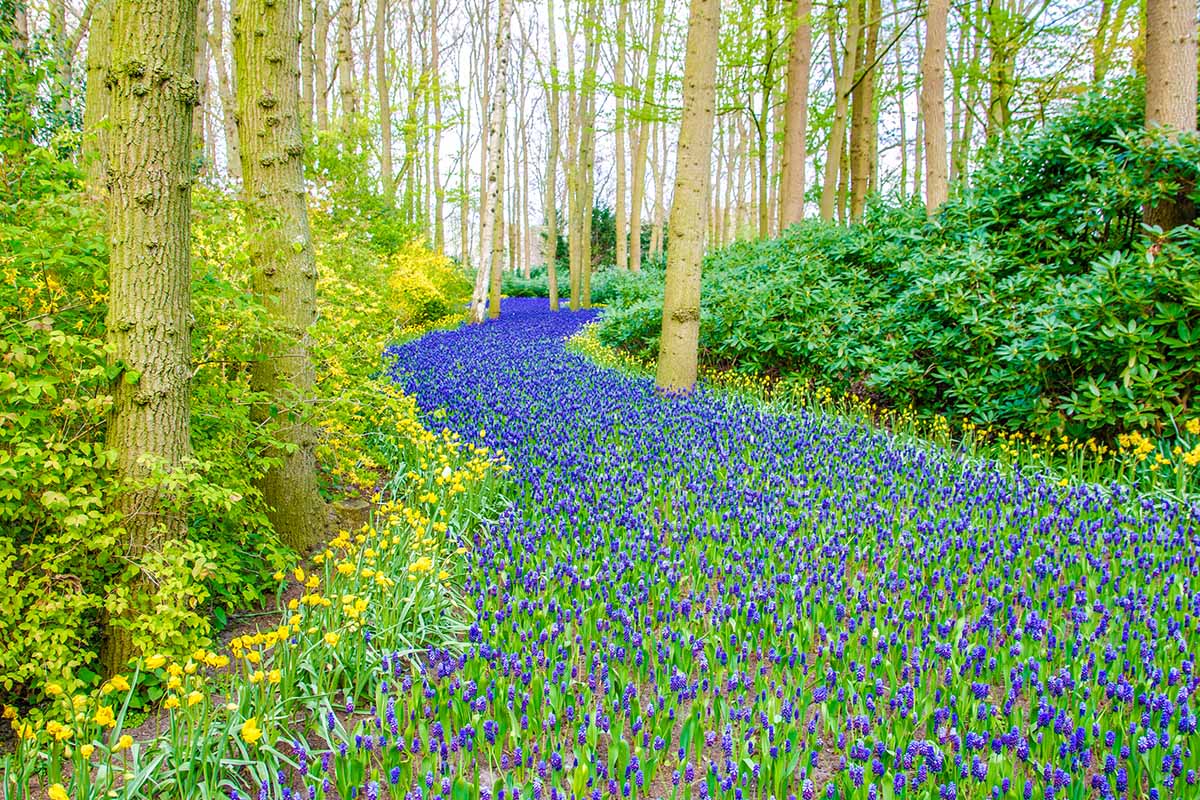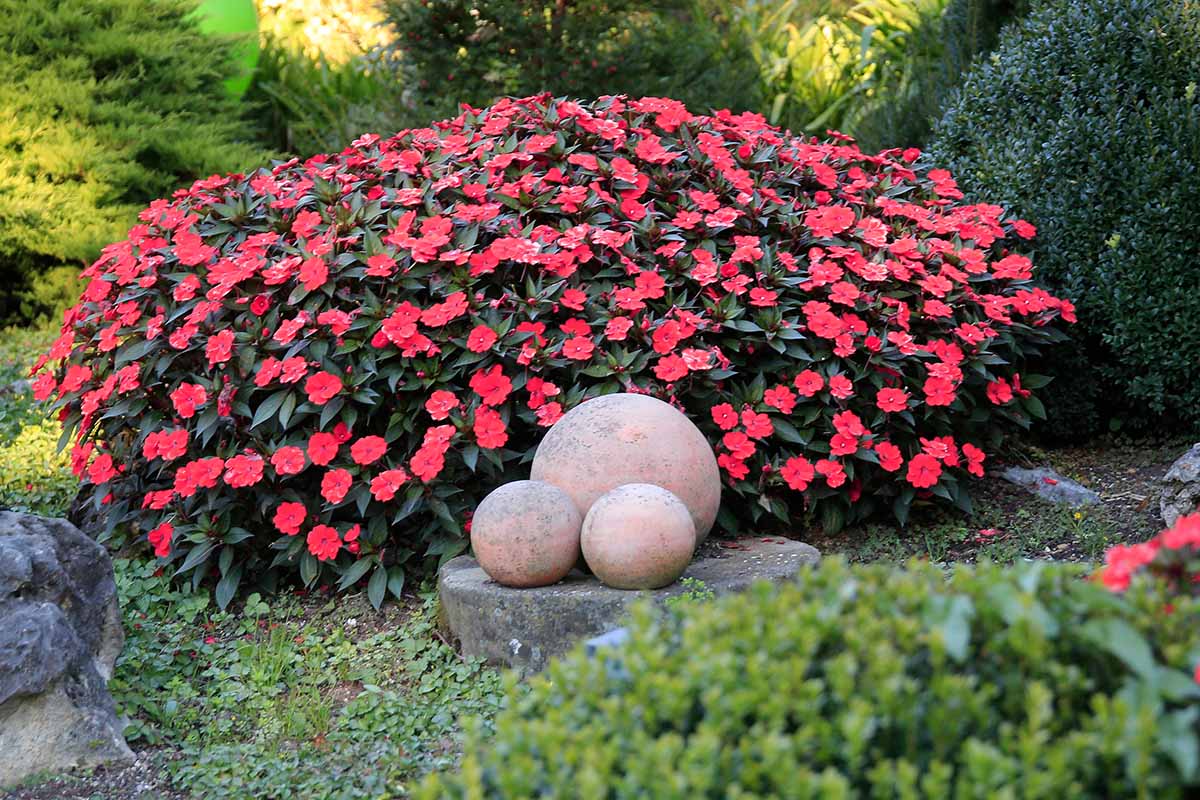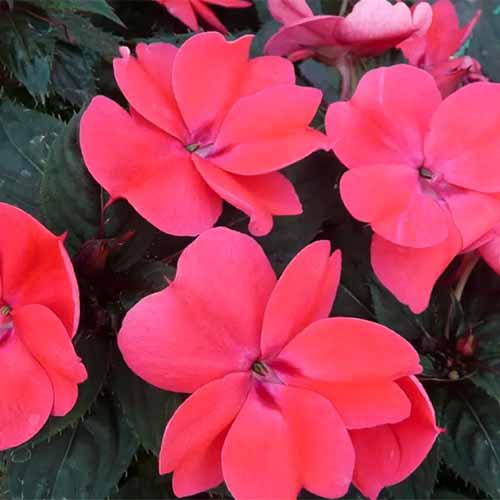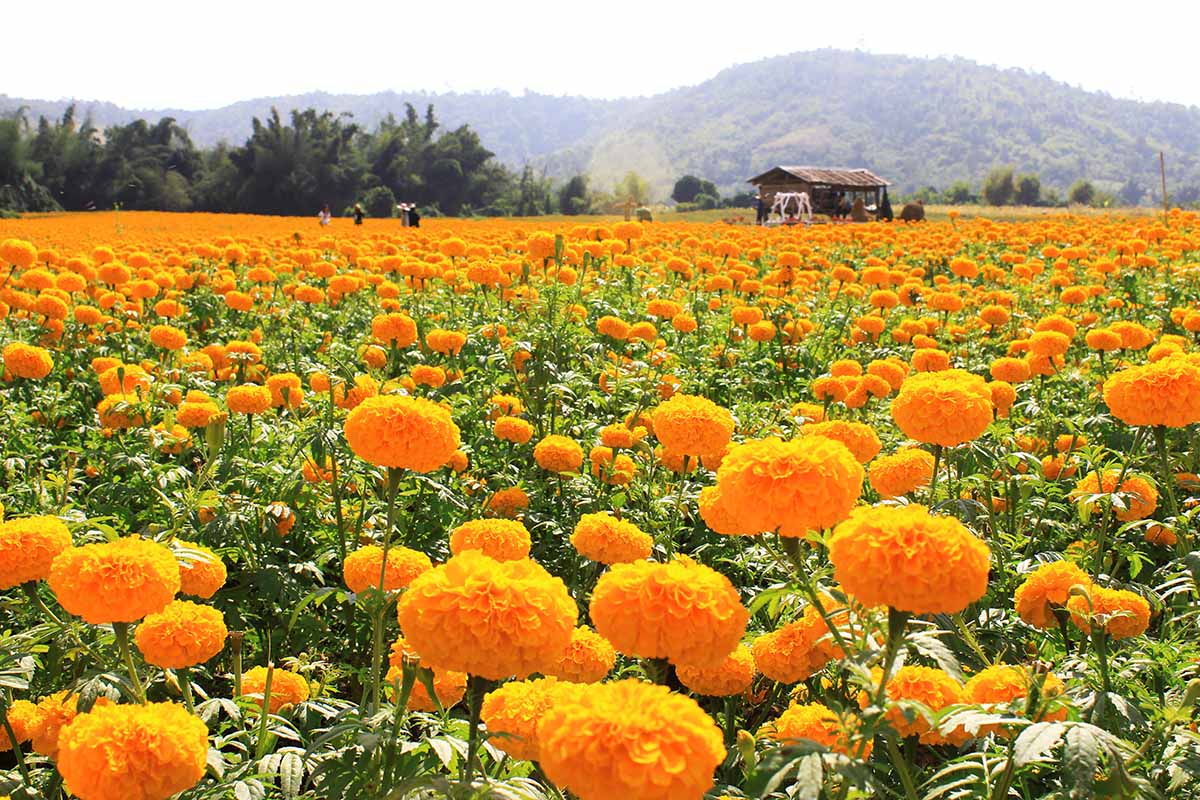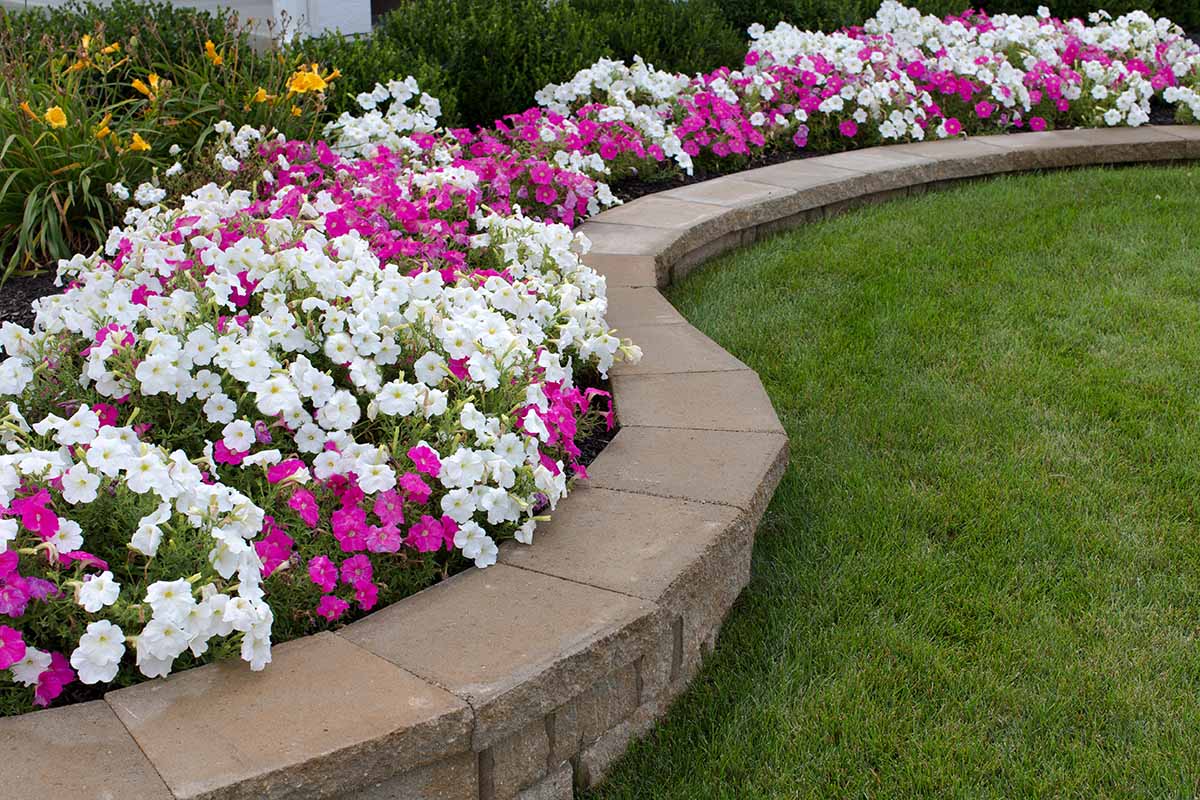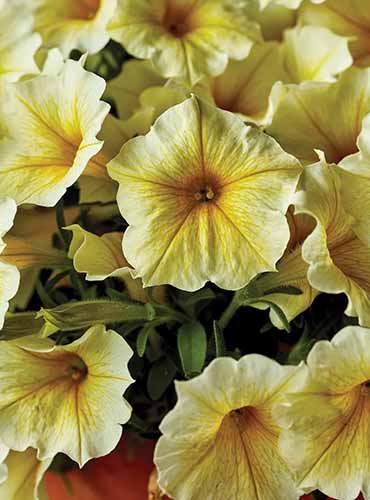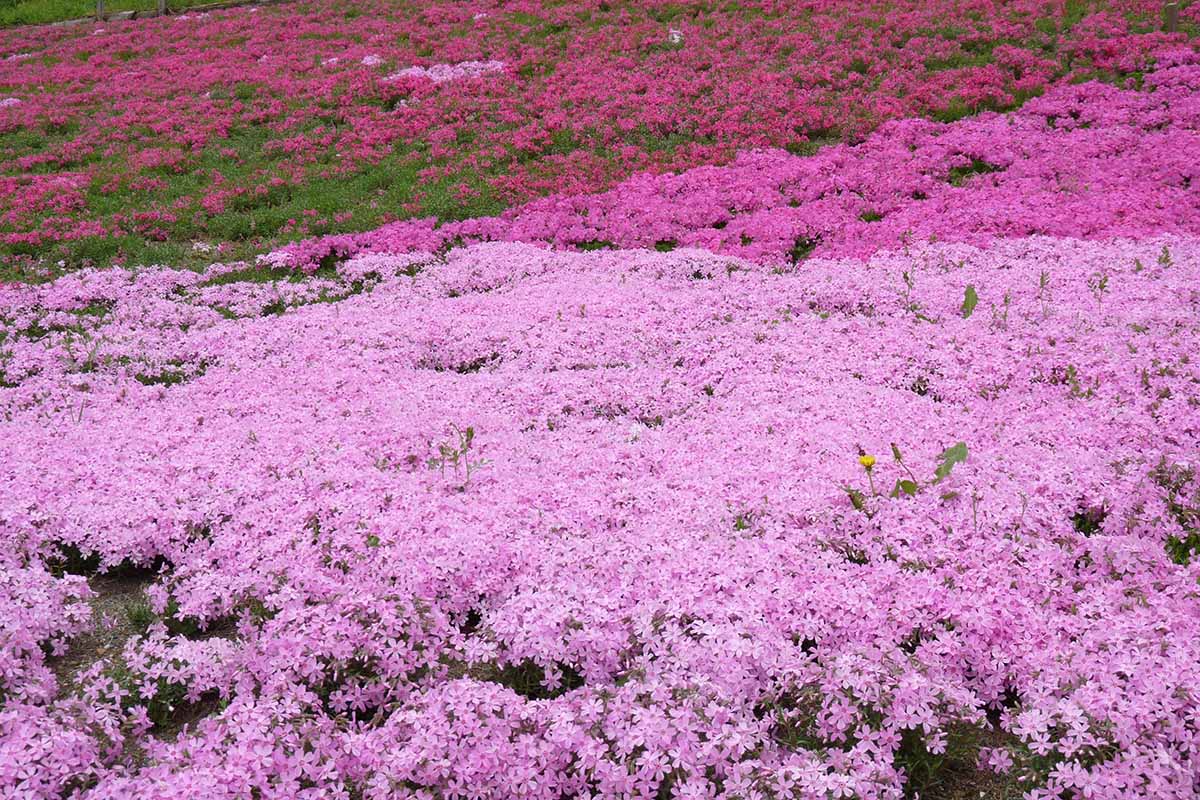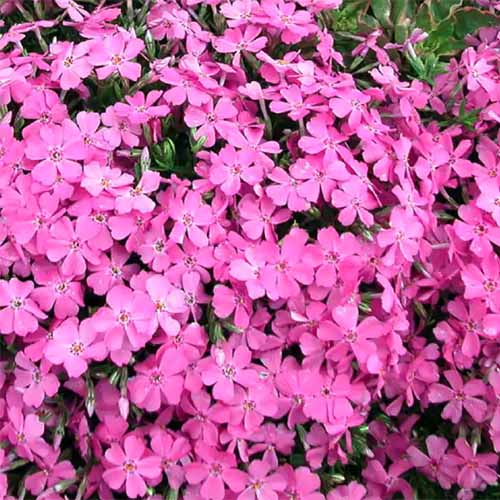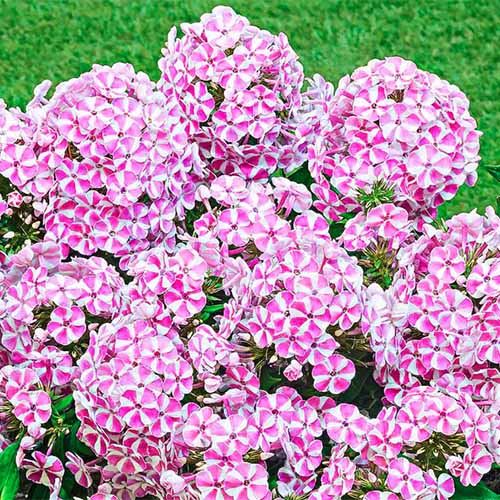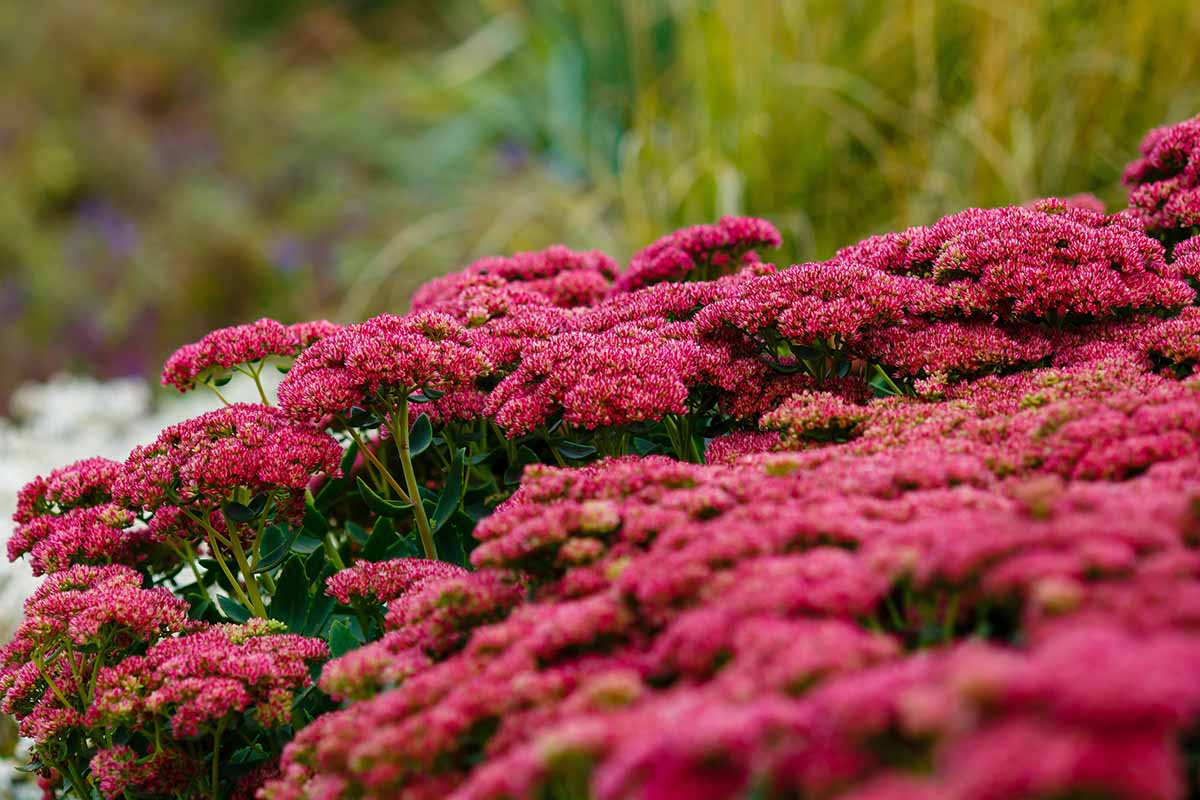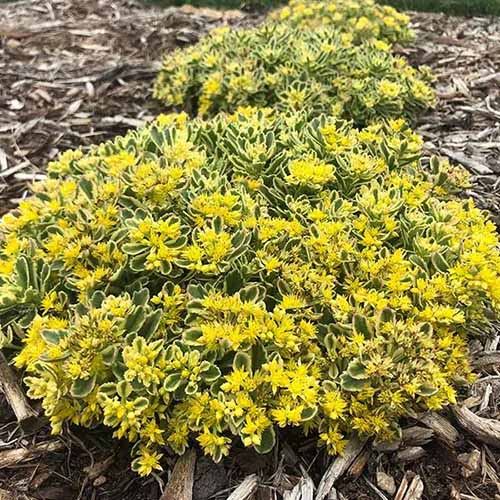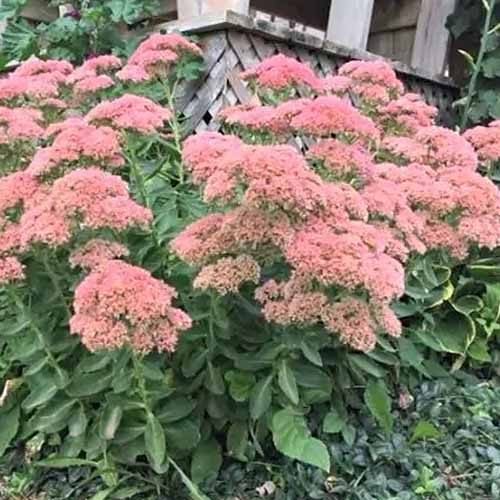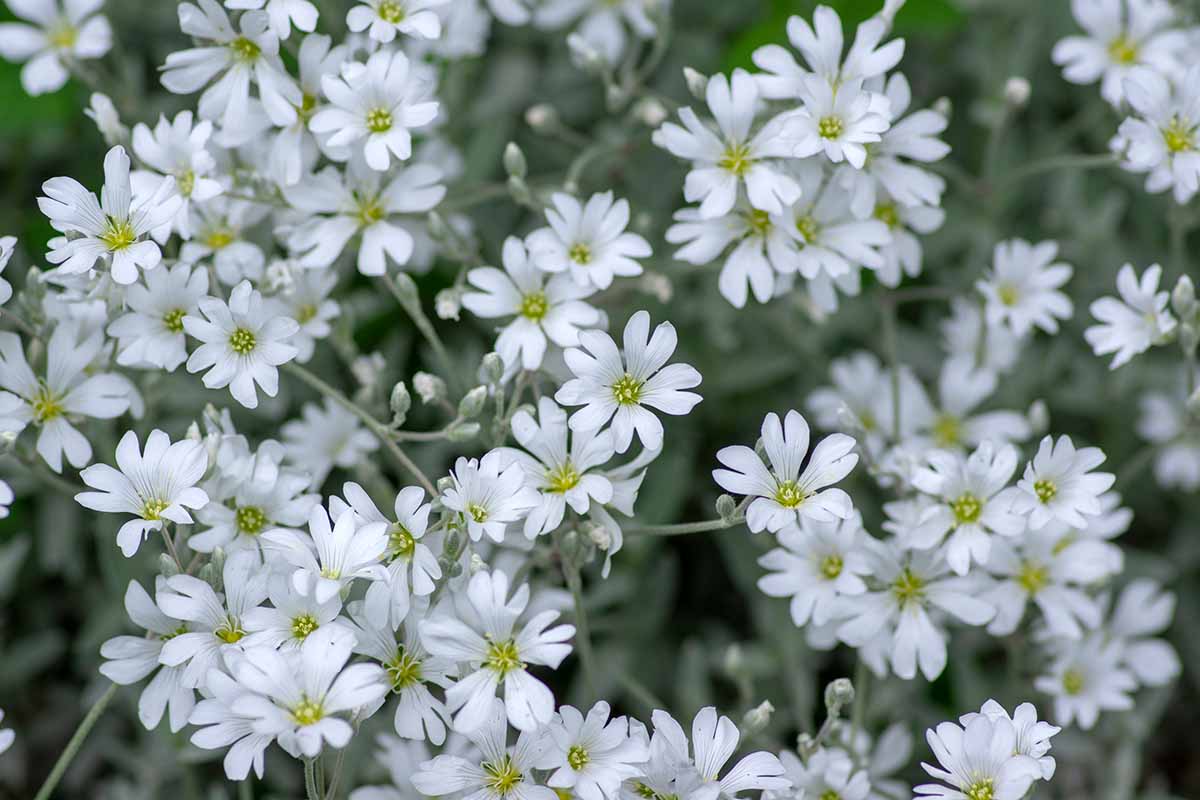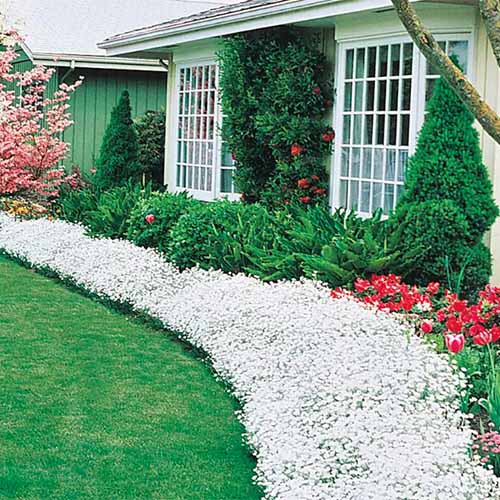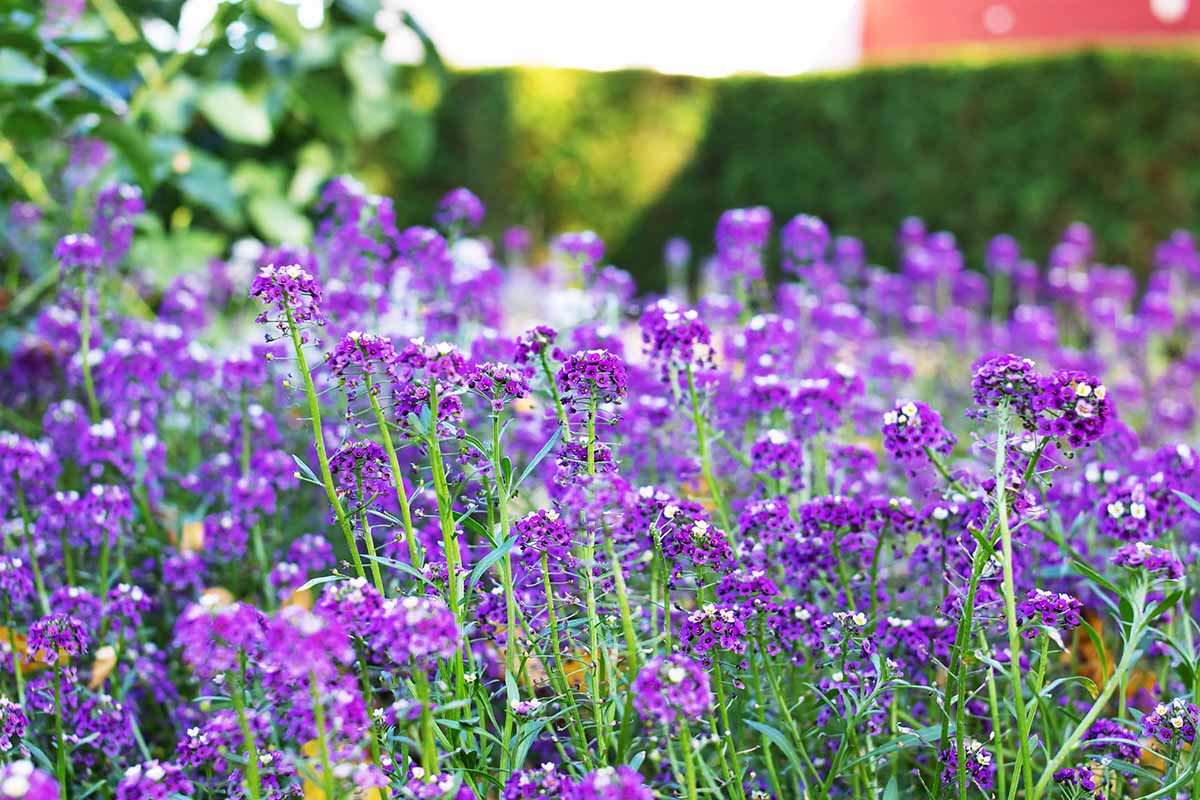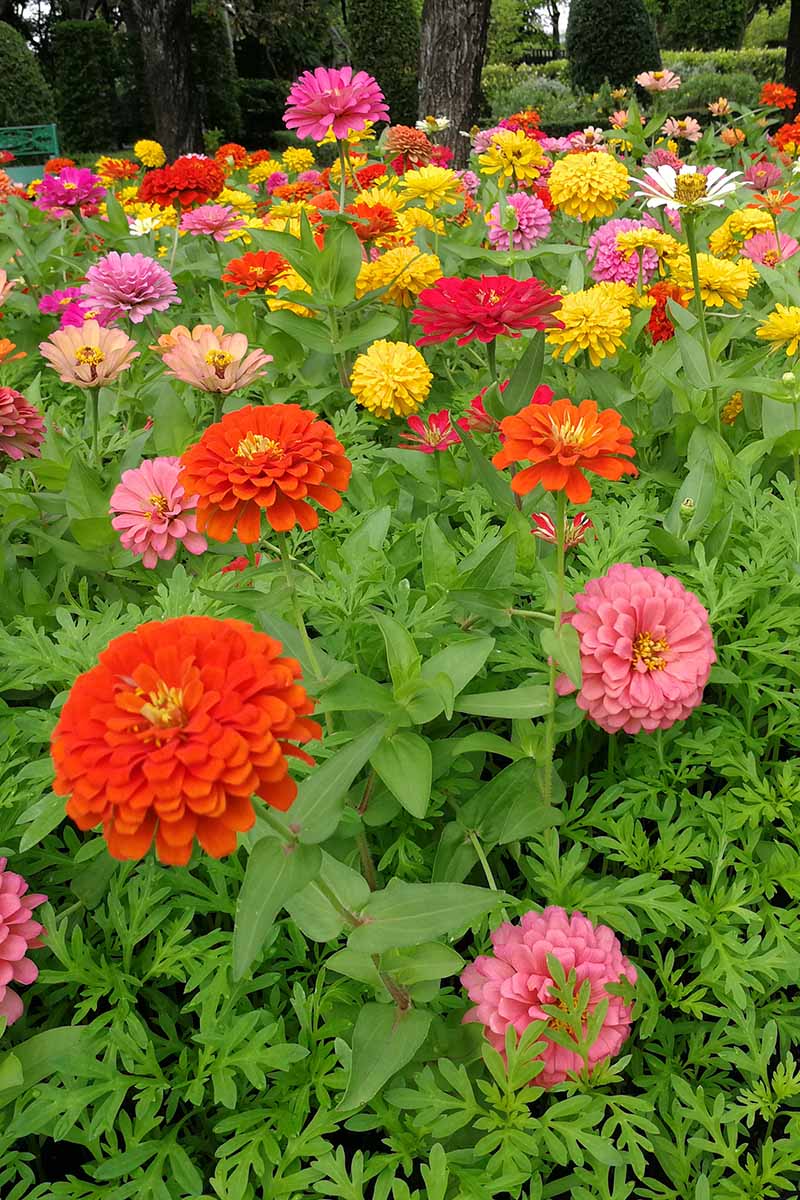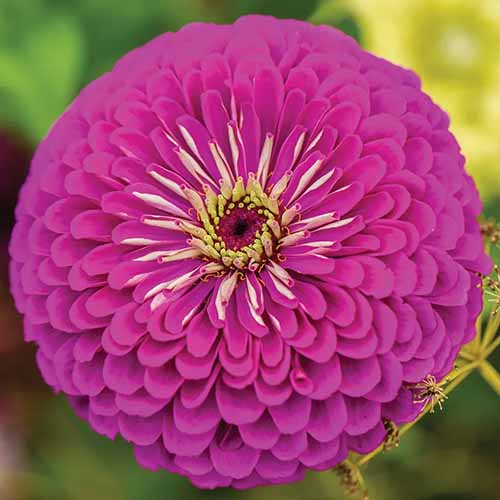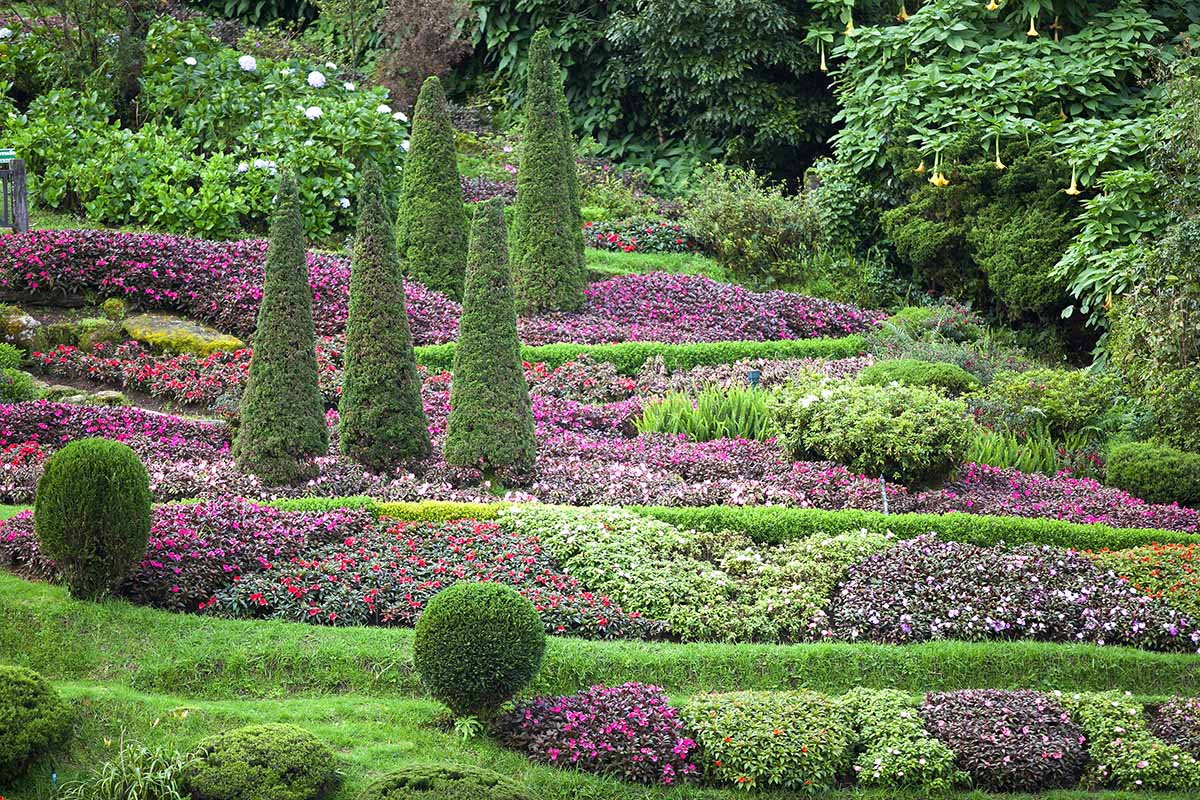Flower groupings are useful in assembling a cohesive mass planting that’s more varied. Many annual and perennial flowers make outstanding additions, especially when grouped together in a complementary manner, or with seasonal appeal in mind. Using complementary or contrasting colors, interesting shapes, and inviting textures, an area can be densely filled for a lush, natural, yet organized appearance. We link to vendors to help you find relevant products. If you buy from one of our links, we may earn a commission. Choosing flowers for this purpose can seem a little intimidating, mainly because there are so many possible options! Let’s discuss some of the best ones to include for maximum impact. Here’s what’s in store:
Ways to Add Flower Groupings to Mass Plantings
Rather than adding individual flowers that are widely spaced in a bed, dense clusters are placed in closer quarters. Spacing them together in this way can smother out weeds, keep the soil below moist and cool, reduce the need for maintenance, draw the eye through the landscape, and fill in space to create visual weight. This is also an excellent choice for hiding an ugly foundation or delineating between sections of sprawling, open acreage. There are several ways to determine which flowers you’d like to include for mass planting. Seasonal color and interest are popular characteristics to consider, and different species can be grown based on their blooming pattern so their colors and shapes add interest in succession throughout the year. For a stunning sea of color to fill a hillside or a large expanse of lawn, you might choose one or two varieties to include in drifts. In this method, a large swath of plants is installed in a shape that complements and enlivens the surroundings. Structured borders are another common layout, with one type of flower comprising the largest grouping, and other types adding pops of additional color or filling smaller gaps. Borders such as these can be installed to frame a sidewalk, skirt a structure such as a house or barn, or even fill in areas below trees. This type of installation can also separate a patio, pool, or seating area from the lawn beyond. You could also fill an area in with flowers of varying heights for a cascading appearance. The taller varieties are placed at the rear, with species of shorter heights added as mid- and foreground groupings. Any of these layouts can be blended with other perennials for multi-season impact, including evergreen foliage that remains beautiful and dense even in cooler weather. Heuchera, hostas, liriope, lavender, ornamental grasses, cacti, and even mosses can be interspersed in mass plantings in appropriate climates, to add additional texture and prevent barrenness or unsightly gaps between blooming seasons. Azaleas, camellias, and rhododendrons, as well as many other types of shrubs, can also be used. Here, we’ll focus on flowers.
How to Plan Flower Groupings
The first step in coordinating a layout is assessing the lay of the land. Each landscape or garden has a different set of conditions, such as shaded areas, topography where water pools or drains off, or structures that need to be taken into consideration. Soil conditions, regional weather patterns, and annual rainfall are also important to consider. For example, xeriscaping with drought-tolerant species is a better choice for gardens in arid climates with sandy soil, whereas tropical types are better suited to hot, humid zones. Just as in any other type of planting, choose specimens that are suited to your regional climate, soil conditions, and the composition of your garden or yard. Matching your chosen specimens up based on their needs is the way to go, since they’ll be sharing common quarters. Bear in mind that mass plantings generally look more balanced when an odd number of plants are used. Even-numbered installations can sometimes appear awkward or unnatural to the eye. Instead, group specimens in quantities of three, five, seven, and so on. The following considerations and methods of organizing your groupings can also come in handy:
By Height
As I mentioned, groupings can be arranged by height to create a cascade of blooming color and texture. Varying heights can be used to form a pattern that draws the eye or separates spaces, and fills in space to add density. Height can also be helpful in hiding unsightly structures or creating a living screen to enclose a secret, private garden space. Seasonal blooming patterns should also be considered for this type of layout, as staggered blooming can look strange in a cascading installation.
By Season
Take into account when the flowers will be in bloom. If the goal is to have a lush bed of vibrant tones in the spring, with greenery remaining through other seasons, then choose flowers that bloom at the same time. Foliage types and tones will also come into play, so the varieties you choose should be able to pull double duty if they do not die back entirely during seasons when they are not in flower.
Annuals and Perennials
Just as blooming times should be considered, it’s important to decide whether to use annuals, which will need to be replanted each year unless they self-seed, or perennials, which will return in subsequent years. If you’d rather not have to repeat the process of planting each year, spending money on new seeds or starts each time, then perennials may be the best choice – unless you save seeds or allow the flowers to self-sow. Low maintenance requirements are a key benefit of mass planting.
Texture and Color
Designing your layout based on the available textures and colors works best for creating drifts, or in larger settings where a variety of mass plantings can be brought together to create contrast. When utilizing this method, complementary or contrasting colors are paired together, drawing the eye in even from a distance. Alright – onto the best part! Get out your gardening journal, because it’s time to start planning. Let’s discuss which flowers work best for planting en masse.
21 of the Best Flowers for Mass Planting
Even though this is a substantial list, it isn’t exhaustive, and there are so many other possible choices of flora that could be included for a stunning result. Most of these have growth habits that create a blanket of color or texture when planted together, while some produce abundant blossoms that reach toward the sky for a spectacular look with added height. Hybrid A. x arendsii is very popular in home gardens, and you may find varieties of A. chinensis, A. japonica, A. thunbergii, and A. simplicifolia to choose from as well. These perennials grow from rhizomes, and they’ll return each year with a thick clump of leafy foliage and tall, feather-like inflorescences. Their scent is sometimes described as being fruity, yet very subtle, and they attract bees and butterflies throughout their bloom season. The fluffy plumage produced by these species is loaded with tiny, densely packed blooms. These open gradually in succession, so the plumes last for a long time – usually for three weeks or more. They also grow quite tall in some cases, with heights reaching one to four feet. When they’re planted in a shady spot, they’ll produce flowers throughout spring and summer in most regions, though flowering will be reduced in full shade. Colors range from soft white to deep burgundy with deep green foliage. As astilbe grows, it tends to spread, and plants will eventually need to be divided. It’s best to allow about 18 inches of space between them. Astilbe Rhizomes Several colors and types are available from Spring Hill Nursery via Home Depot, like this pack of three that includes rhizomes for varieties in red, pink, and white. Learn more about how to grow astilbe in our guide.
2. Begonias
There are thousands of species and cultivars of begonias, and quite a few are commonly chosen as additions to the home garden in suitable climates. We’ll cover garden go-to’s that are known for their mass planting appeal here. Most of these do not have a noticeable scent or produce much nectar, so if you’re looking for a pollinator-supporting specimen to install en masse, begonias may not be your best choice. Wax begonias, sometimes referred to simply as bedding begonias, are popular for adding blooming color and glossy, waxy leaf textures in densely planted beds. These have a fibrous root system and showy flowers, and hybrid cultivars of Begonia x semperflorens and B. x benariensis are commonly available in garden centers. These are frost-tender and typically considered annuals throughout most regions that experience chilly winters, but they can survive as perennials in Zones 10 and 11. Bedding begonias are often brightly colored in tones of pink, red, or sometimes white, with foliage that can range from green to bronze. Most reach heights of six to 18 inches and bloom between spring and fall in most zones. Place types with bronze foliage in full sun, as they need adequate light for the most prolific bloom production, and others in partial shade. Be sure to water them frequently to avoid allowing their substrate to dry out but make sure the excess moisture drains off well. Learn all about their care in our guide to growing wax begonias. You can find B. x benariensis Surefire ‘Red’ is available in a four-pack of live plants from Proven Winners via Home Depot. Surefire ‘Red’ Wax Begonia A rose-colored cultivar is also available in the Surefire series. Tuberous begonias are another commonly chosen type. They’re just as they sound – plants grown from tubers that will sprout each year in Zones 9 to 11. North of Zone 9, these must be lifted and stored for the winter. B. maxima ‘Switzerland’ is a beautiful example, with large, double, red rose-like blooms and thick, glossy leaves that are nearly black. Sets of five tubers are available from Van Zyverden via Home Depot. ‘Switzerland’ Tuberous Begonia The tuberous types may have an upright growing habit or blossoms that hang downward in a weeping presentation. The upright specimens are more suited to mass planting while the weeping specimens are best for containers or hanging baskets. Nonstop ‘Double Yellow’ produces large, bright yellow, camellia-type double blooms atop green foliage. This specimen, as well as others in the Nonstop series, reach up to 18 inches in height with an 18- to 24-inch spread. Nonstop ‘Double Yellow’ You can find ‘Double Yellow’ tuberous begonias available from Nature Hills Nursery in a two-pack of dormant tubers. This series also includes red, white, pink, orange, salmon, and bicolored cultivars.
3. Black-Eyed Susans
Perhaps you know Rudbeckia hirta by its common name, black-eyed Susan? These native North American wildflowers are found throughout the United States. The most common species of Rudbeckia, the flowers of this plant are easily distinguished by their yellow petals and brown to black centers. Other species and certain cultivars may have green, red, or white petals instead. In the wild, black-eyed Susans are often found in sunny open fields or near forest borders. As long as they’re receiving full sun and growing in moist but well-drained soil, they’re tolerant of heat, drought, and less than ideal soil composition. For impactful, natural appeal, this is one flower that can’t be beat. Not only can it make an instant meadow out of any large area, it also attracts pollinators of all types. Try it as a carefree border planting just beyond a forest edge or add it en masse surrounding a barn or outbuilding foundation. Black-eyed Susan is a mounding perennial that spreads via rhizomes, returning year after year in Zones 4 to 9. Outside of these zones, they may be grown as annuals. ‘American Gold Rush’ ‘American Gold Rush’ is available in #1 containers from Nature Hills Nursery. This hybrid cultivar was the All-American Selection Winner in 2020, judged best based on its uniform three-inch golden blossoms, attractive foliage, and heat tolerance. It has a compact habit, with classic yellow petals and dark brown eyes. Most species in this genus grow up to 26 inches in height with a spread of three to four feet. Learn about their growth habits and find caretaking tips in our guide.
4. Celosia
Celosias are part of the Amaranthaceae family – the amaranths – and it’s easy to see the resemblance. If you like astilbe but you’d prefer brighter colors and you have the appropriate growing conditions, feather or plume-type celosias are for you! C. argentia plants need full sun and well-drained soil to thrive. These are annuals that can sometimes return as short-lived perennials or power through the whole year in warmer climates. If you’re gardening in Zones 9 to 11, you may not need to replant every year, and it’s important to note that these plants self-seed readily. Otherwise, they can be removed from the garden at the end of the season. And the colors – oh, the colors! Shocks of flame red, yellow-orange, and deep lavender are common among those in the First Flame series as well as others, and as a bonus, the leaves are even edible if you wish to partake. There are dwarf varieties available that only reach about six inches in height, but the majority of these will grow to about 10 to 14 inches. Give celosia about six to eight inches of space at planting time, unless you’re growing the larger types, which will need about 12 inches of space. Bear in mind that they’re also heavy producers of seed, so if you don’t want them to self-sow and spread like mad, you’ll need to deadhead the spent blooms to keep a structured bed or shapely border neat and tidy. Seeds can also be collected in lieu of allowing them to spread at will, so you can select where to scatter them instead. ‘Scarlet Plume’ is one option that you may like. This cultivar bears stunning bright red plumes that reach six to 10 inches in height, so they’re great additions to the foreground of a cascading bed. Celosia ‘Scarlet Plume’ Seeds are available in a variety of package sizes from Eden Brothers. Bear in mind that celosias bloom from summer into fall. Check out our guide to growing celosia, and take a look at our roundup of 15 of the best annuals for late summer color for more recommendations.
5. Coneflowers
If you’ve ever seen an herbal supplement that includes echinacea, you might be surprised to learn that this wildflower is a very common choice for mass installations. In fact, some gardeners choose to fill beds with purple coneflowers for the dual purpose of making tea and other types of herbal medicine as well as enjoying the lovely flowers. The most widely known type, E. purpurea or the purple coneflower, is a perennial that not only returns annually, but self-seeds like wild! It’s also native to North America and great for supporting your local pollinators in Zones 5 to 8, with some species and cultivars adapted for regions further north or south. Dusky purple, cone-shaped flowers with dark centers are the standard feature with E. purpurea, and the fact that they’re related to other types of daisies is apparent in their form. However, purple is just one tone available – there are dozens of others that would make a striking choice. Learn more about 17 of the best coneflowers in our roundup. Perhaps orange is more your type? In that case, Echinacea ‘Hot Papaya’ might be the perfect choice, with large, double blooms that were one of the first of their kind! Echinacea ‘Hot Papaya’ Find plants in #1 containers available from Nature Hills Nursery. Coneflowers produce long taproots and are excellent for creating a natural, meadow-like appearance in a grouping. They range in height from about 12 inches to well over two feet, and readily reseed to fill large areas. Learn all about adding coneflowers to your landscape in our comprehensive guide.
6. Cosmos
Cosmos are so named because of the appearance of their blooms, which seem to float like constellations of stars twinkling in a galaxy. They tend to be rather tall – well over two feet in some cases, although there are dwarf cultivars that reach just 12 to 18 inches. This genus is known for its tolerance of neglect and poor conditions. Drought, heat, and sandy or rocky soil are no match for these tough yet delicate-looking specimens. They tend to fill an area with fern-like foliage and cheerful flowers from summer through fall, and many self-seed to return each spring. They’re also native wildflowers endemic to the Americas, so they’re choice pollinator-friendly specimens. While most are annuals, there are a few perennials available that grow from rhizomes. C. bipinnatus and C. sulphureus are common annual choices for the landscape, and both are suitable for growing in Hardiness Zones 2 to 11. Chocolate cosmos, or C. atrosanguineus, are perennials that grow from tubers. These will return annually in Zones 8 to 11, but they will need storage or protection from chilly temperatures to survive the winter in areas north of these zones. White cosmos such as ‘Purity’ are a gorgeous choice to include with other pastels, or to break up bright swaths of color. Cosmos ‘Purity’ Find seeds in packets of one ounce, one quarter pound, or one pound available from Eden Brothers. Or, for a shock of floating electric yellow, you could grow ‘Yellow’ sulfur cosmos to create a buzzing meadow of pollinator-attracting color. Sulfur Cosmos Seeds are also available from Eden Brothers in packets of one ounce or one quarter pound. Learn more about how to grow and care for cosmos in our guide.
7. Chrysanthemums
Perhaps you know these by their common name – mums. You can learn all about them in our complete guide to growing chrysanthemums. While there are about 13 different classes of flower types in the Chrysanthemum genus, some known solely as florists’ varieties, the ones best suited for mass planting are the mound-forming species and cultivars, such as anemone types. Some varieties are known as cushion or bushel-basket mums because of their tightly spaced, rounded growth habit. These cultivars were bred in the 1970’s for their lower heights and mounded form. Garden mums are autumn staples that you can often find at home and garden centers, and even some grocery stores in many areas, in classic harvest colors including red, orange, and yellow. If you’re looking for a rustic, earthy perennial that is very low maintenance and inexpensive that blooms from summer to fall, these are a great choice. They make a lovely grouping when they’re installed about 12 to 18 inches apart. Cushion mums are very hardy, and suitable for adding to the garden in Zones 5 to 9. In both height and spread, they’ll reach about 18 to 24 inches. Mammoth ‘White Daisy’ Mums are available in summer and fall from local stores, or you can purchase cultivars such as Mammoth ‘White Daisy’ and Mammoth ‘Bronze Daisy’ in three-inch nursery pots from the Spring Hill store via Home Depot. Plants in the Mammoth series, developed by the University of Minnesota, are vigorous and feature large, four-inch, semi-double flowers with bright yellow centers.
8. Daffodils
If the first image that comes to mind when daffodils, or narcissus, are mentioned is the standard yellow or white flower, with its simple cup-and-saucer form, then you’re in for a treat. Daffodils grow from bulbs, making them a perennial specimen in Zones 3 to 9. Place them in full sun or partial shade and be sure to provide good drainage for stunning mass plantings. Daffodils also naturalize readily, creating gorgeous drifts of color throughout the landscape over time. Though daffodils are deer-resistant and voles are repelled by them, beware of squirrels and other winter-foraging animals that consider these bulbs to be a welcome treat. If these pests are a problem in your area, you’ll most likely need to lift the bulbs and store them through the winter. There are many types to choose from for landscape planting, in a range of colors including orange, pink, and coral, as well as yellow and white. Some of these are early blooming, and some flower later, so plantings can be staggered for colorful appeal throughout the growing season. Some cultivars, such as ‘Replete’ and ‘Tahiti,’ have been bred to produce double centers. This showy form is stunning en masse. ‘Replete’ Daffodils ‘Replete’ has peachy-pink centers surrounded by snow white petals. Bulbs are available in sets of five from Burpee. ‘Tahiti’ Daffodils ‘Tahiti’ has yellow blooms, with deep orange fringed ruffles at the center. Bulbs are available in packages of 10, 20, 50, or 100 from Eden Brothers. While most varieties do tend to have a lovely scent, selective breeding has reduced some of their pollinator-attracting qualities. Double blossoms in particular are not the best choice for supporting your local bee and butterfly populations. However, naturalized species with single flowers, such as N. poeticus, have more appeal to these beneficial insects. Learn about 15 more of our favorite types in our roundup, and find all the details to grow and care for your plants in our full guide to growing and caring for daffodils.
9. Daylilies
Did you know there are thousands of species, cultivars, and hybrids of daylily? It’s true, and some of these are strong candidates for mass planting. Their long stems lift the brightly colored blooms they produce above their foliage, lending a wild and free appearance. Even though they’re commonly referred to as lilies, Hemerocallis species are not true lilies. Perennial daylilies grow from fleshy, tuberous roots that spread underground and form clusters, while true lilies grow from bulbs. Both types have blooms that are very similar in form. When daylilies are grouped en masse, the foliage, or scapes, form fountain-like tufts of green leaves. Most species remain evergreen in more mild climates, and they can be planted in Zones 3 to 9, adding color and texture to the landscape even after the blooms have died off. Each blossom only lasts one day – hence the name – but each specimen will produce dozens per season, sometimes well over 200 per plant in ideal growing conditions. One of the most commonly chosen cultivars for grouping, ‘Stella D’Oro’ is available from Burpee in bare root form. ‘Stella D’Oro’ Daylily This is a petite variety that can be clustered together, forming masses of bright yellow, two-inch blooms on 10- to 12-inch stems above green scapes. Most varieties bloom from spring to fall and will eventually need to be divided as they spread. They range in height from about 12 inches to well over four feet, with an 18- to 24-inch spread. Full sun is best for daylilies, except for darker-colored cultivars that need protection from harsh afternoon sun. Learn how to plant, grow, and care for daylilies in our complete guide.
10. Dianthus
The Dianthus genus contains over 300 species, including D. caryophyllus, commonly referred to as carnations, and sweet williams or D. barbatus – both of which are common choices for mass planting. While sweet williams and pinks are mass-forming plants with blooms that form on shorter stems, carnations can grow to two feet above their foliage, depending on the variety. Most types are perennials that retain a tuft of evergreen, grassy foliage in mild or warmer zones; however, both annual and perennial types readily self-seed. Their gorgeous colors and often fancy, showy blooms will grace the landscape between spring and fall. If you need a compact flower for mass planting, Dianthus is an excellent choice in Zones 3 to 9. Check to make sure the one you select is suited for your regional conditions. For a monotone shock of fuchsia to purple, perennial maiden pinks (D. deltoides) can be spaced about four inches apart, along a walkway or in an open area where they’ll form a carpet of color. ‘Georgie Peach Pie’ Dianthus ‘Georgie Peach Pie’ plants are available from Burpee. These 10 to 12 inch plants produce profusions of white blooms with peachy-pink centers, separated by a fuchsia band. They also give a clove-like scent that adds to their appeal en masse. Plan to allow about six to 12 inches in between for larger dianthus plants such as carnations, depending on which variety you choose. Learn more about how to grow dianthus in our guide.
11. Geraniums
There are a few different types of geraniums that are well suited for this type of planting. The various species are often described as hardy or garden types such as cranesbills and pelargoniums, ivy types, and scented types. Cranesbill geraniums are hardy perennials that return each year with simple, single blossoms in jewel tones of blue, lavender and pink. They’re an excellent choice for mass planting as they are low maintenance and have a rhizomatous spreading habit. Pelargoniums are set apart by the shape and form of their blossoms – whereas cranesbills are simple, symmetrical, and five-petaled, pelargoniums have two upper petals that differ from their three lower petals and often have showier colors. They’re available in a wide range of tones such as deep red, bright fuschia, salmon, and dark purple. They are less hardy than cranesbills, usually considered annuals in most regions where winter temperatures fall below about 30°F. Learn more about differentiating between cranesbills and pelargoniums in our complete guide to growing scented geraniums. While geraniums do add beauty, color, and texture to an installation, they’re not particularly appealing to pollinators, so other species should be chosen to support them instead. In a bed or border, garden geraniums (Pelargonium x hortorum) make a lovely choice. They’re also available in single colors and variations that include striping and double blossoms, all of which have equally striking foliage. Most species and cultivars are mound-forming and prefer full sun, and soil that drains well. Pinto Premium Series You can find Pelargonium x hortorum seeds from the Pinto Premium series in packages of 100 at True Leaf Market in various colors including coral, rose, salmon, lavender, and white. This series is known for its stunning four- to five-inch-wide flower clusters and attractive banded foliage, and for its drought and heat tolerance. These stems of these specimens attain a height of 18 inches at their tallest, and plants have a spread of 12 inches. These are annuals in all regions north of Zone 10, and perennial in Zones 10 and 11. The rhizomes can be dug up and stored through the winter and replanted in the spring. Learn more about how to grow garden geraniums in our guide.
12. Grape Hyacinths
It’s important to note that, in some settings, grape hyacinths can become invasive. However, if you have an expansive area to fill in and need a low-height, virtually maintenance-free perennial to add a spreading field of color, this is a good choice. You’d probably never guess that Muscari species are members of the Asparagaceae family, based on their appearance. Their purple springtime blooms that resemble clusters of grapes and their grass-like foliage are hardly similar to asparagus. Not only do Muscari plants self-seed, but they also spread by forming offshoots or bulblets. While they prefer full sun, if you’d rather not have to fight them off so they don’t overtake a major portion of your lawn, you may prefer to place them in partial shade. Most species in this genus grow best in Zones 3 to 9, and some of the larger types are extremely cold hardy. Learn more about grape hyacinths that are perfect for mass and border plantings in our roundup. Bear in mind that they don’t offer much scent and don’t appeal greatly to pollinators. The indigo-blue M. armeniacumi are the most common, and they do make a striking presentation, but there are other colors and forms available as well. White makes a lovely addition in a grouping with other soft colors, and M. aucheri ‘White Magic’ is a perfect choice if this is what you’re looking for. Muscari ‘White Magic’ Bulbs are available in quantities of 25, 50, and 100 from Eden Brothers. Most varieties only reach about eight inches in height max, and the grassy foliage typically spreads to about the same width, although the foliage dies back while they are still in bloom. Learn more about growing grape hyacinths in our guide.
13. Impatiens
Also known as busy lizzies thanks to their proficient spreading tendencies, members of the Impatiens genus are very diverse in form, but I. walleriana is the most commonly chosen species for bedding plantings. This species grows in a dense, rounded mound, producing blooms throughout the spring and summer. Deadheading regularly can help to keep them blooming strong – sometimes for as long as 200 days in a season! Available colors truly run the gamut, ranging from bright white to peach, purple to deep red, some with candy striping or contrasting center tones. They’re also available in single or double blooms. While I. walleriana prefers partial shade, especially in high temperatures, some cultivars and series have been bred for better sun and heat tolerance. This pink variety that is part of the SunPatiens series, bred by Sakata to tolerate more full sun than other varieties, is available in a six-cell growers tray from Home Depot. SunPatiens ‘Pink’ All impatiens self-seed, which is where their common name, touch-me-not, is derived from. With the slightest touch, their seed pods burst open, and scatter widely in the fall, so it can take a bit of supervision to keep them contained in a specific border or shape. But, impatiens are outstanding for filling that space out with lush foliage and blossoms. Impatiens are annuals in Zones 2 through 8, and perennial in Zones 9 to 11 that prefer moist, well-drained soil. Note that they’re not particularly drought-tolerant and they’re also not a pollinator favorite as they produce little to no nectar. Plants can range in height from six inches to well over two feet in height, so spacing will depend on which type you choose. Learn more about how to grow impatiens in our guide.
14. Marigolds
Out of all of the species on this list, marigolds are likely the easiest to grow. When I was a kid, my family would gather the seeds they produced and save them in a coffee can for the next year at the end of their summer to fall blooming season – and that is the entirety of the maintenance we performed in terms of what was required to care for them. They belong to the Tagetes genus, which contains over 50 species. Most marigolds are bright yellow or orange annuals, although there are some perennial types, such as T. lucida, also known as Mexican tarragon. Most varieties self-seed, or seed can be collected for an inexpensive to free option for planting in consecutive years. Though they’re very tolerant of less than ideal growing conditions, aim to add marigolds to your flower beds where they’ll receive full sun and good drainage. Their bright blooms come in a few different forms, with each specimen producing many flowers at a time atop fern-like foliage. Suitable for growing in Zones 3 to 10, marigolds add a sunny touch in dense plantings where they’re grouped closely together. The Durango series features dwarf cultivars of the T. patula species, also known as French marigolds. A variety of cultivars are available in this series, in a host of bright colors and bicolored options. ‘Flame’ has bright red showy flowers with yellow edging, ‘Bolero’ is bright gold, with red tips. Red, yellow, and orange colored blooms are also available – or why not purchase a Mix of all the colors? Durango Series Mix The Durango Mix is available in packets of 100, 500, 1,000, or 5,000 seeds from True Leaf Market. Allow enough spacing based on the variety you choose, as marigolds can range from six to 24 inches in height, with an equally broad spread. You can read all about caring for these lovely bedding plants in our complete guide and then take a look at 31 of the best options available for more suggestions.
15. Petunias
Petunias are a staple in many landscapes, planted year after year for their vast array of colors and forms. There are five distinct types of petunias: floribunda, grandiflora, multiflora, milliflora, and ground covers. Learn which is which in our guide to the different types. Multiflora and ground cover types are the best to select for mass planting due to their dense bloom production, compact size, and tolerance of wet conditions. You’ll find these in jewel tones and white, spotted and striped varieties as well. Milliflora, however, are well-suited for border plantings as they have a petite size that can be grouped in large numbers. Petunia x hybrida ‘Bees Knees’ is a favorite ground cover type with creamy yellow blooms that have darker yellow centers and a trailing, low-lying habit that can cover a large area. ‘Bees Knees’ Purchase a bundle of four plants from Burpee. Multifloras are more compact with smaller blooms than grandifloras, and they typically exhibit better resilience in windy or wet climates. P. nana ‘Rose of Heaven’ is perfect for filling in beds with a blanket of flowering color no more than 12 inches in height. ‘Rose of Heaven’ Find seeds in a variety of package sizes available from Eden Brothers. Petunias bloom from spring to fall, and they’re known for their excellent heat tolerance. It may be surprising to learn that they’re part of the Solanaceae family which includes tomatoes and tomatillos! While they do attract butterflies and moths, bees tend to pass them over for other flowers. They’re also a bit challenging to grow from seed in some cases. They can be grown from cuttings, but most gardeners choose to purchase starts each year instead. They’re also not known for being particularly fragrant, although some hybrids have been bred for improved scent, including those in the Tumbelina series, such as ‘Priscilla,’ which produces double indigo-purple blooms with deep purple veining. ‘Superstar’ is another cultivar in the Tumbelina series, producing large, double blooms with stunning deep burgundy blooms with white edging. Plants in this series received the Royal Horticultural Society’s Award of Garden Merit because of its sweet vanilla aroma and double blooms. Find tips on growing petunias in our guide.
16. Phlox
You could feasibly design an entire mass planting using nothing but phlox, and still have dozens of options to choose from. Between their form and their available color variations, it might take you some time to determine which ones to use. Creeping or moss phlox (Phlox subulata), for example, is an excellent blooming ground cover that will spread throughout a space. It only reaches about four to six inches in height, but P. stolonifera is also an option for creeping ground cover that reaches seven to eight inches in height. Both are wonderful replacements for grass, with pollinator-friendly color. Expect to find creeping phlox in jewel tones such as lavender, indigo, red, white, and pink. For a stunning taller specimen, P. paniculata, or garden phlox, stands up to five feet in height and it also comes in a range of colors, from soft white to deep orange or red, with some candy-striped varieties available as well. No matter the species, place these in soil that drains well, and plant in full sun. There are both annual and perennial choices, so depending on your needs, there is likely a perfect one for you. Growing conditions in Zones 4 to 8 are ideal for these species. Creeping Phlox Deep pink creeping phlox can be purchased in two-and-a-half-quart nursery pots from Home Depot. They also have a wide selection of taller species available, such as P. paniculata Bambini ‘Candy Crush.’ ‘Candy Crush’ This cultivar reaches 10 to 12 inches in height, with profuse pink and white striped blooms. Find it in a three-pack of bare roots from Spring Hill Nurseries via Home Depot. Expect blossoms from mid-spring to midsummer. Spacing varies depending upon the species. Learn more about creeping phlox in our guide.
17. Sedum
Sedum, sometimes known as stonecrop, is a large genus that contains over 400 species. Members of this genus are classified as succulents because their leaves store water, making them plump and full. Sedum adds lovely texture to a mass planting outside of blooming times. These succulents are perennial in Zones 4 to 9, and most bloom between July and October in these regions. Their bloom form sets them apart for planting en masse, as healthy specimens will form flower clusters that add gorgeous color and visual weight to an installation. It’s also easy to grow sedum in less than ideal conditions, such as sandy or rocky substrate, provided that they receive full sun with good drainage. This makes them good candidates for xeriscaping as well. Aside from their easy caretaking, their foliage comes in many colors, shapes, and sizes. Some varieties come in low-height groundcover form, such as Sedum x ‘Boogie Woogie’ aka Rock ‘n Low ‘Boogie Woogie,’ which is a hybrid series bred for its spreading, six- to eight-inch height and bright yellow blooms. Rock’n Low ‘Boogie Woogie’ You can find plants in #1 containers available from Nature Hills Nursery. Taller specimens, such as ‘Autumn Joy,’ which is one of the most popular choices, grow to heights of 18 inches or more with an equal spread. ‘Autumn Joy’ You can find ‘Autumn Joy’ available from Nature Hills Nursery, along with a wide selection of other types. Because of the wide range of heights and spreads within this genus, be sure you know what the mature size is expected to be to space them accordingly. Find tips on growing and caring for sedum plants here.
18. Snow-in-Summer
Known commonly as snow-in-summer or silver carpet, Cerastium tomentosum is a species that spreads in a silvery, low-growing carpet of foliage which bursts with snow white blooms in late spring and early summer. While it’s a little fussier than some of the other members on our list – specifically needing full sun in areas without high heat or humidity, and well-drained, sandy soil – it also spreads quickly and will add interest with its felted foliage year-round. Snow-in-summer is very drought tolerant, making it a perfect choice for xeriscaping in cooler regions. Because it only attains about six inches in height, it’s a great foreground or ground cover choice that will contrast nicely with other species with deeply colored foliage or flowers. Add this distinctive perennial specimen to your landscape in Zones 3 to 7, but be sure to mow them down after blooming ends if you don’t want them to self-seed. This species also spreads via runners so plan to keep the creeping habit in check by trimming it back. In zones where the summer is hot and humid, plant them in partial shade. Snow-in-Summer You can find bare root C. tomentosum plants available from Home Depot. For a cultivar that remains more compact and doesn’t spread as readily, try ‘Yo Yo.’ This selection has been bred for a four to six inch height and works perfectly in a rock garden.
19. Sweet Alyssum
With fluffy tufts of tiny blooms that grow in low masses, it might not surprise you to learn that sweet alyssum (Lobularia maritima) belongs to the Brassicaceae family. If you’ve seen its cousin broccoli in bloom, I’m sure this makes sense! These plants prefer full sun or partial shade and grow as annuals in Zones 3 to 8, or short-lived perennials in Zones 9 to 11. They can self-sow to come back each year, producing large quantities of seeds, though some hybrid cultivars may not be true to the parent. In addition to the standard white, a variety of colors are available, such as this stunning purple cultivar known as ‘Royal Carpet.’ ‘Royal Carpet’ Sweet Alyssum Seeds are available in a variety of packet sizes from True Leaf Market. Different varieties of L. maritima can range from about three to 12 inches in height, but they do tend to spread, creating a fluffy sea of color from spring to fall, or even longer in mild regions. Be sure to allow about four to six inches between each. Learn more about how to grow sweet alyssum in our guide.
20. Tulips
If you’re not a tulip aficionado, perhaps you didn’t realize that there are over 3,000 cultivars and more than a dozen divisions, classified by bloom form! That’s a lot of tulips – parrot, lily-flowered, peony, fringed, standard – it’s going to be a tough choice to decide on one or two. Any of these varieties will make a gorgeous addition to your bed, border, or open space, and they’ll come back year after year from bulbs. In ideal growing conditions, they’ll return for between three to six years, and sometimes even longer. After two to three years, you will likely need to dig the bulbs up to divide them. Zones 3 to 7 provide ideal growing conditions for tulips, and all you’ll need to provide is full sun (or partial shade in warmer climates), water, and safety from hungry critters. If you’re like me, Eden Brothers’ selection of tulips will make you feel like a kid in a candy store – have fun browsing for your favorites! There are so many that stand out, but one stunner, ‘Tom’s Favorite,’ produces deep, burgundy-red double blooms. ‘Tom’s Favorite’ Tulips Their eye-catching color gradually darkens through the season to deep purple, making a double showing! Find bulbs in quantities of 10, 20, 50, and 100, from Eden Brothers. There’s quite a range in sizes between different varieties, but a good rule of thumb is to be prepared to leave about two to four inches of space between bulbs. Learn all about growing and caring for tulips in our guide.
21. Zinnias
For a tall, colorful, cheerful option, zinnias are a perfect choice. They’re heat tolerant, sun loving, and make excellent cut flowers if you prefer. Many varieties reach well over three feet in height with singular blossoms and lance-shaped green foliage. One of the most common species chosen for planting en masse is Z. elegans, reaching about one to three feet in height. The color choices available for this species come in an astounding array – you’ll find pink, purple, yellow, red, orange, and white, available in single and double blooms. There are compact dwarf cultivars available as well, such as those of the Thumbelina series, and these generally reach only six to 10 inches in height. They work well in the foreground or arranged in a bed or border and come in colors similar to their taller counterparts. Another species that sometimes appears in beds and borders is Z. angustifolia, which typically reaches a height of about eight to 12 inches. There are fewer color choices available for this species, with most being white, orange, and yellow. They’re sometimes referred to as creeping zinnias. These annuals are super easy to start from seed, and the flowers last from late spring throughout summer, and sometimes into fall, in Zones 3 to 10. Unlike some of the selections on our list, zinnias are an excellent choice for pollinator-friendly landscaping as they attract bees, butterflies, hummingbirds, and wasps. Be sure to provide full sun and consistent watering; even though they’re drought tolerant, they thrive when water is regularly available. They also need a bit more spacing than some of the others on our list because they’re susceptible to powdery mildew when grouped too closely. An heirloom variety such as ‘Purple Prince’ is sure to please, with full, dazzling, dahlia-type purple blooms atop stems of up to three feet in height. ‘Purple Prince’ Zinnias If you live in a wetter zone and need an option that is mildew-resistant, this is your go-to! Find packets of 50 seeds available from Burpee. Learn everything you need to know about planting and growing zinnias in our guide.
Blooming Splendor En Masse
As I mentioned, this list is an excellent starting point to decide which species you may want to include in a mass installation, but there are hundreds of possibilities to choose from. Don’t be afraid to use interesting shapes and layouts for your project and play with the design – the best groupings can sometimes occur over time and with trial and error. Research the best species for your climate and your budget ahead of time to avoid wasting time and money – it’s often better to choose perennials if you don’t want to buy new seeds or starts each year. What type of installation do you have in mind? We’d love to hear about your plans or what kind of layout you decided to go with – and pictures of your garden are always particularly enjoyed! It never hurts to have more suggestions and ideas to work with when you’re planting flowers, so check out these guides for more helpful information:
15 of the Best Flowering Ground Covers to Meet Landscaping ChallengesChoosing the Perfect Flowering Perennials: 5 for Your Shade Garden13 of the Best Flowers for Attracting Pollinators to the Garden
